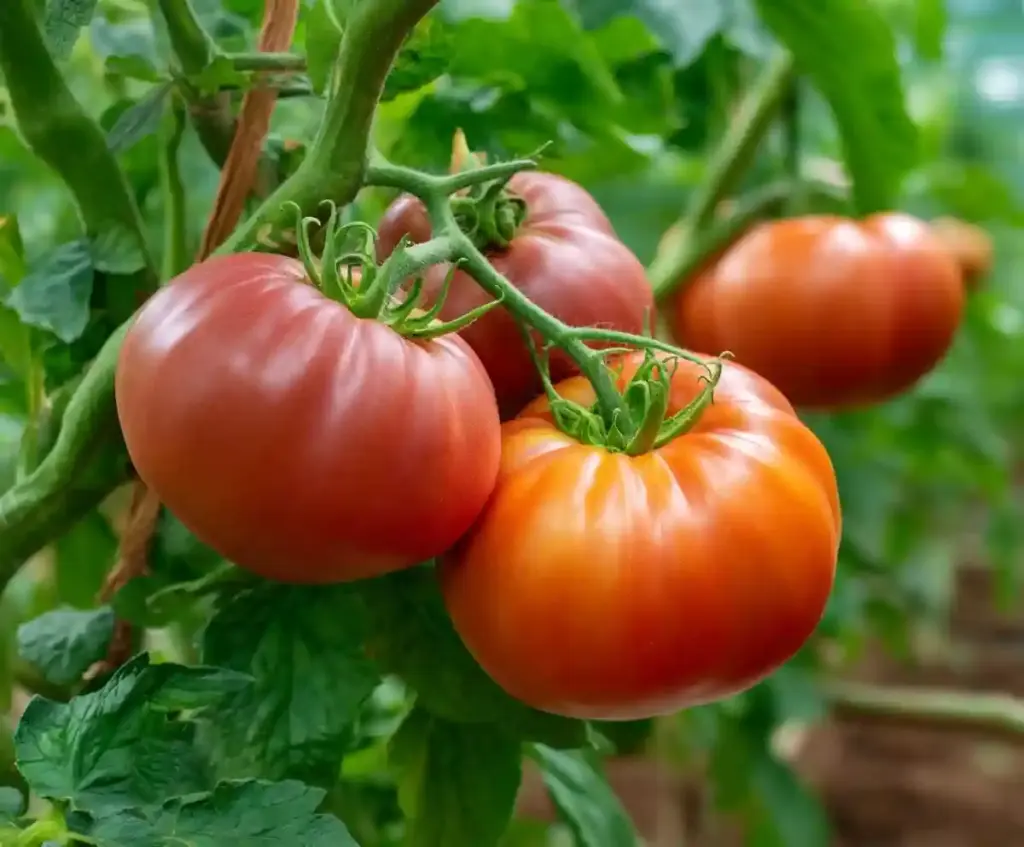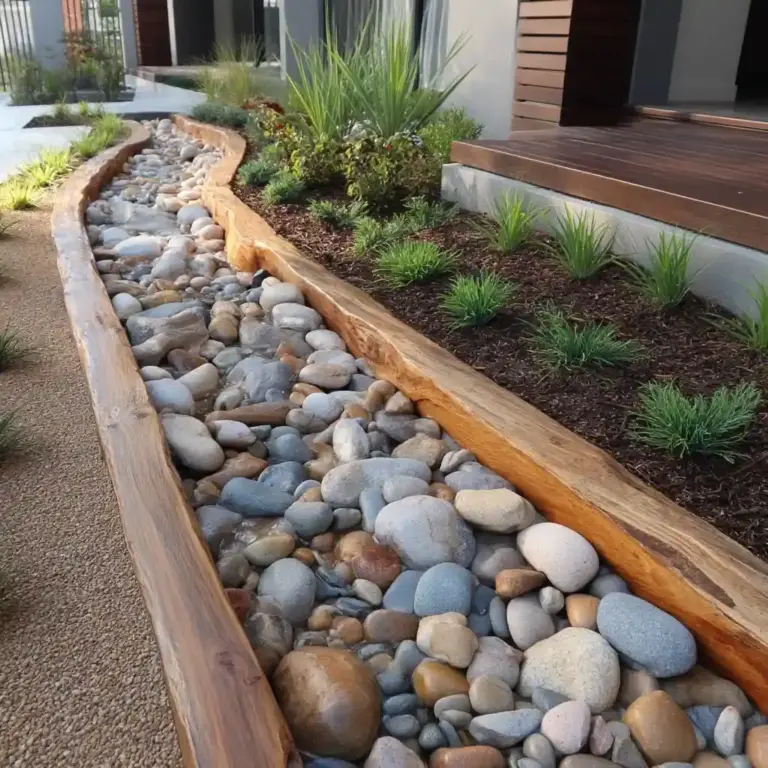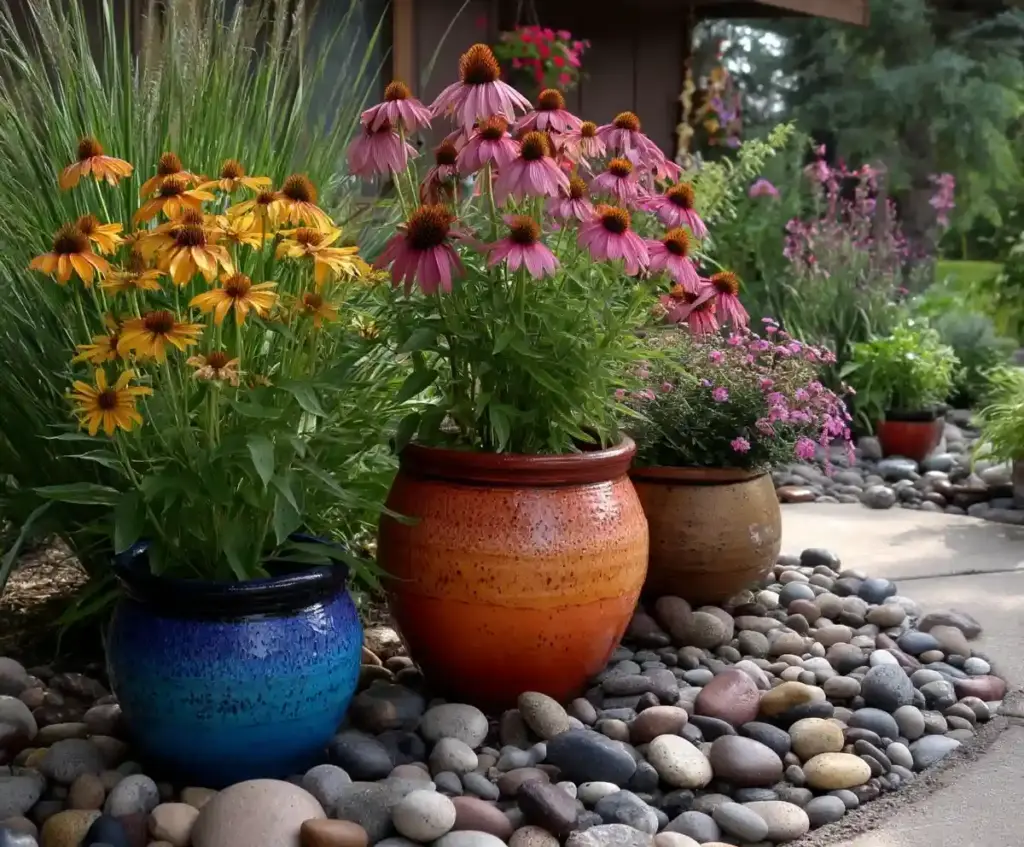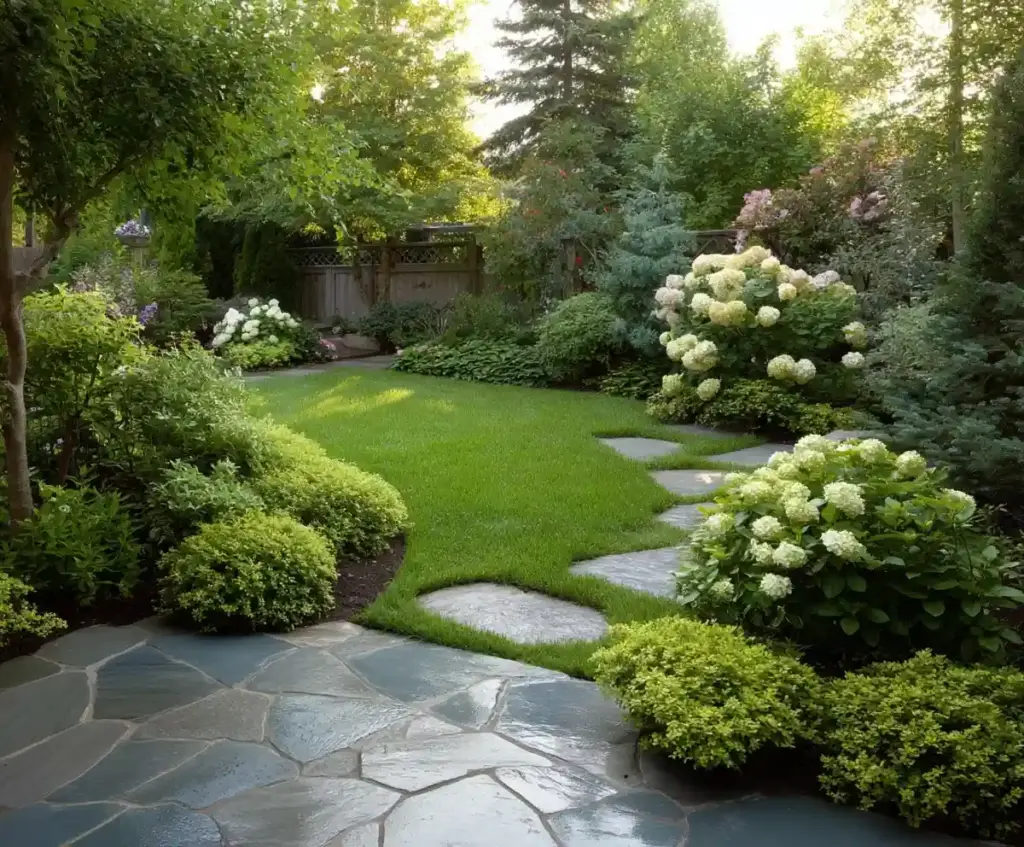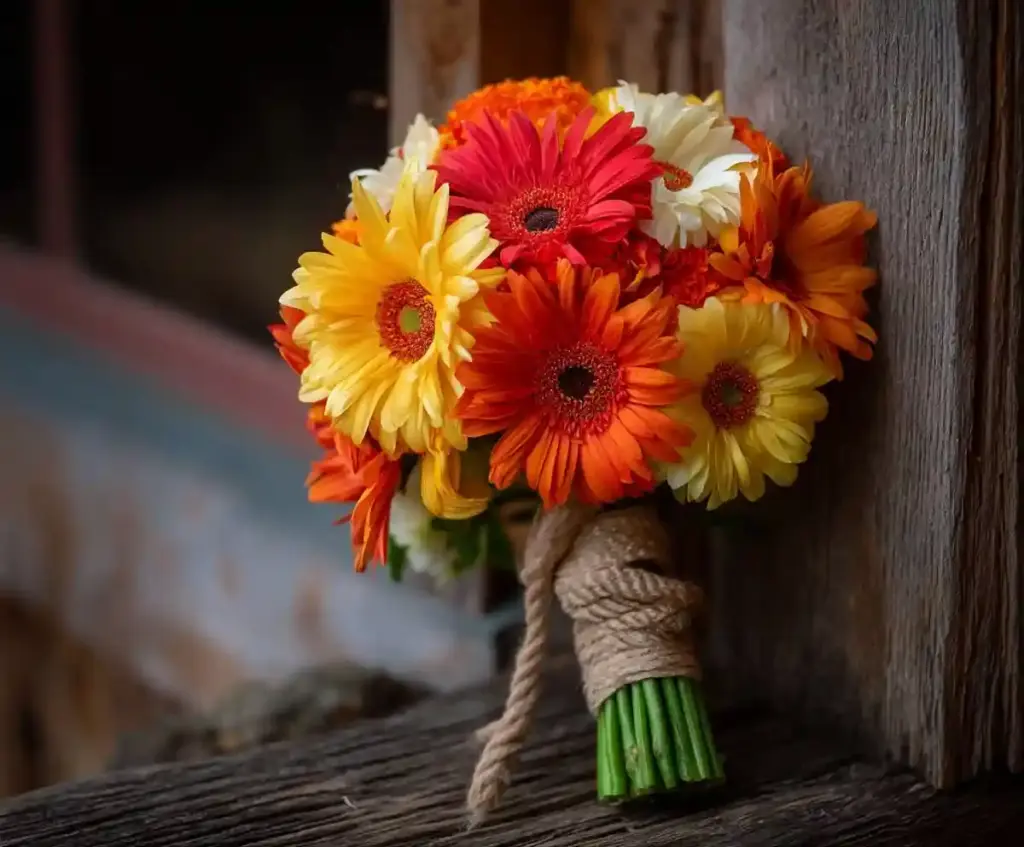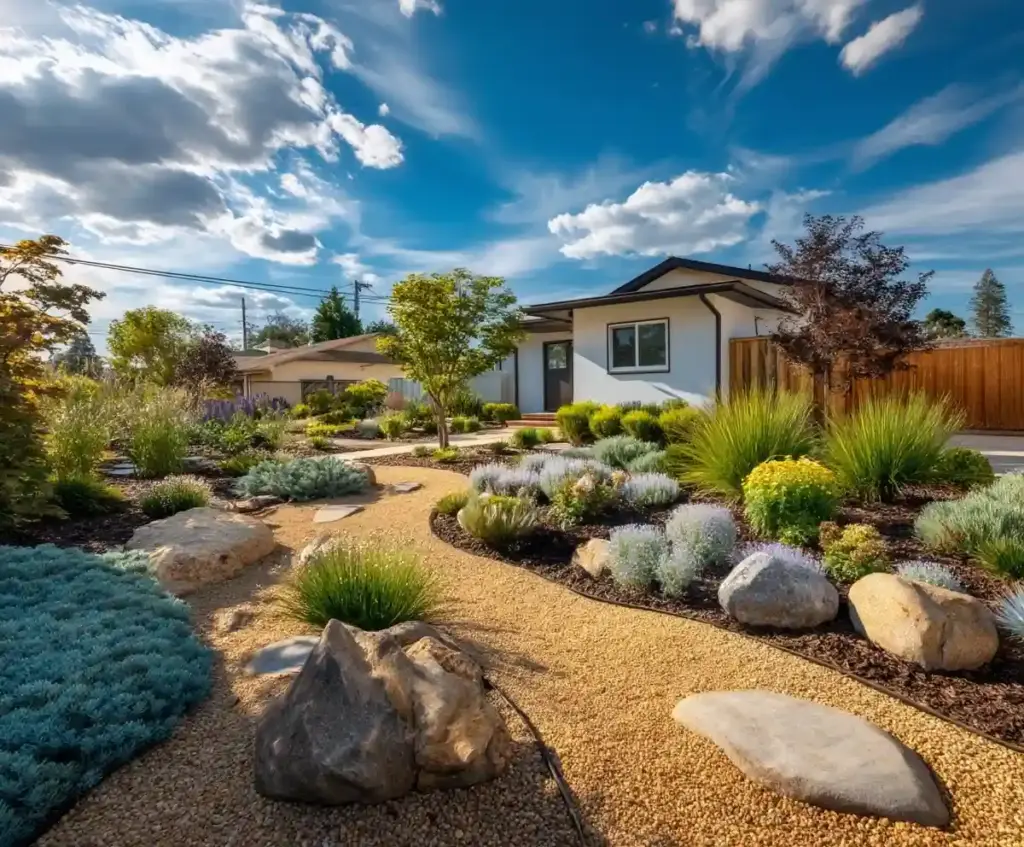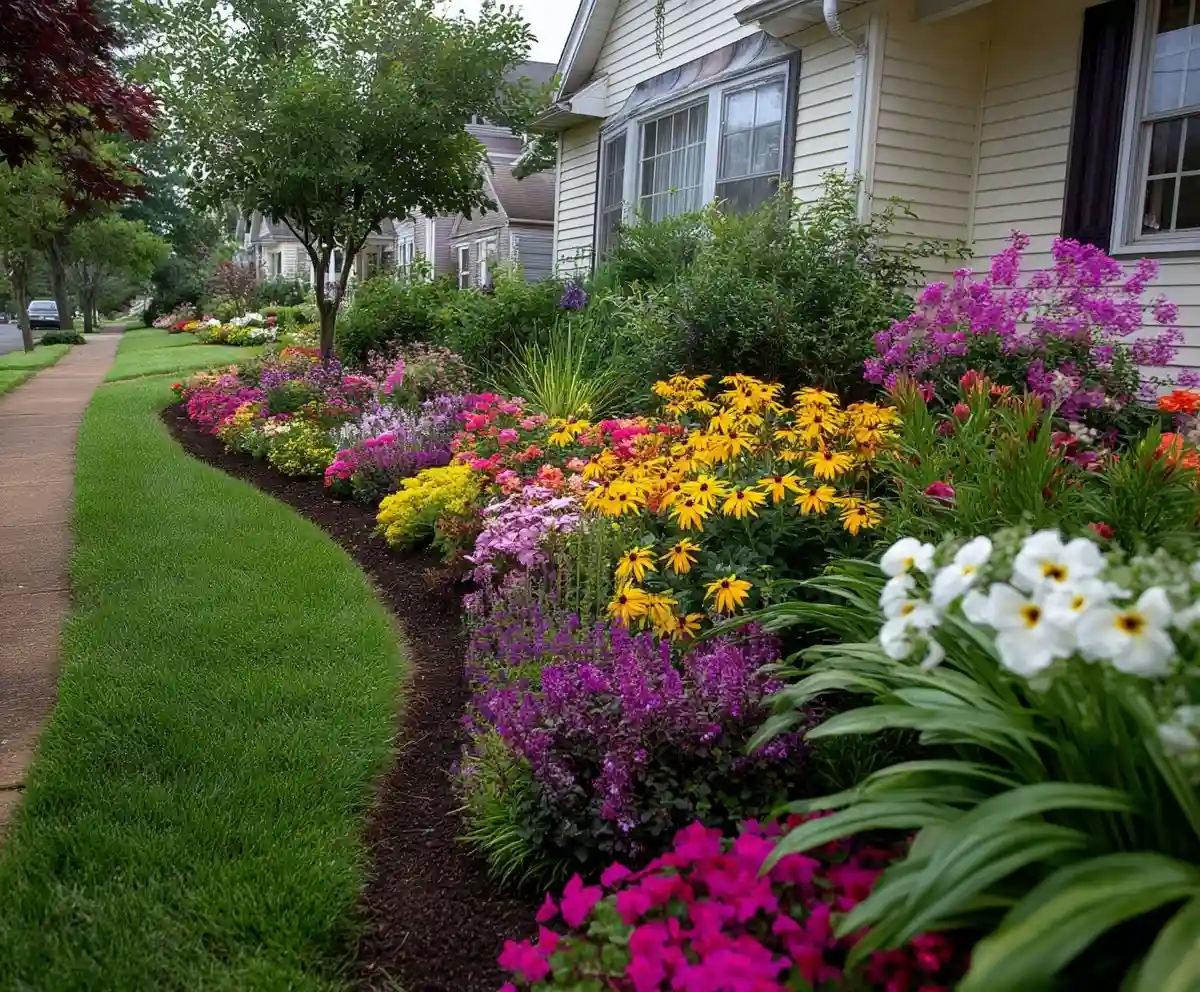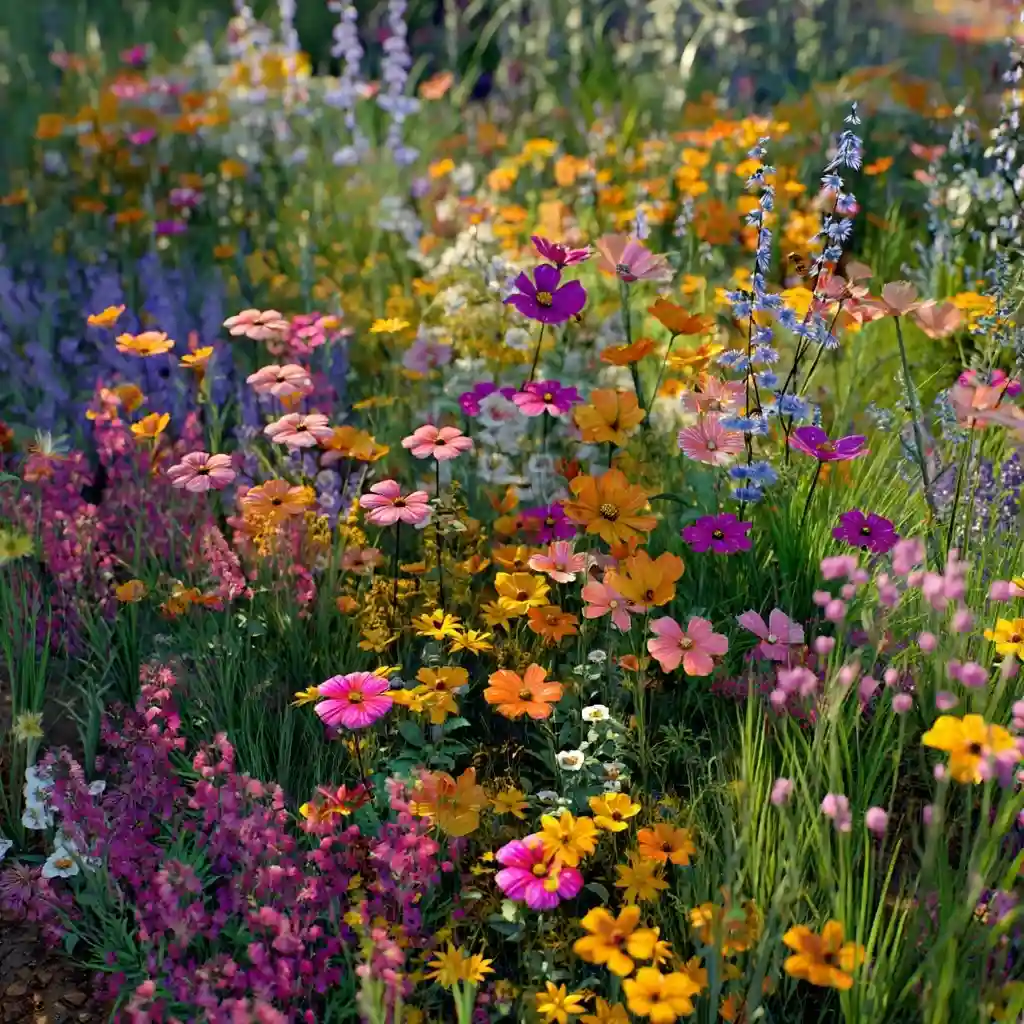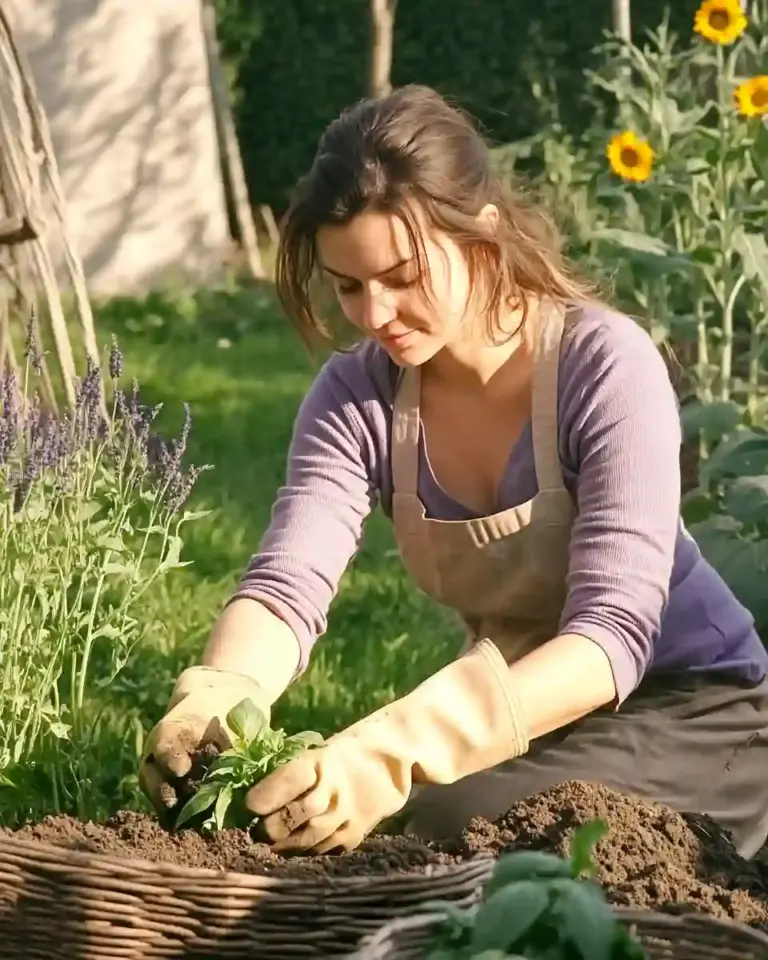Flower bed ideas can transform any outdoor space into a vibrant, inviting garden. Whether you’re working with a small backyard, a sprawling lawn, or just a cozy corner near your porch, the right flower bed layout can make your home feel more alive. From adding pollinator-friendly blooms to arranging plants for year-round color, the possibilities are endless. The key is to combine aesthetics with function, creating a garden that reflects your personal style while also supporting local wildlife.
Table of Contents
1. Plant Wildflowers
One of the simplest yet most charming flower bed ideas is to plant wildflowers. These blooms create a natural, slightly untamed look that instantly adds life and color to your garden. Wildflowers are not only beautiful but also low‑maintenance, making them perfect for busy gardeners or those who prefer a more relaxed gardening style.
Choose a mix of annual and perennial wildflowers for a dynamic display that changes through the seasons. Flowers like black‑eyed Susans, coneflowers, and coreopsis thrive in many regions and require little watering once established. Another bonus is that wildflowers support pollinators, from butterflies to honeybees, helping your garden thrive as part of the local ecosystem.
2. Lean Into Native Flowers
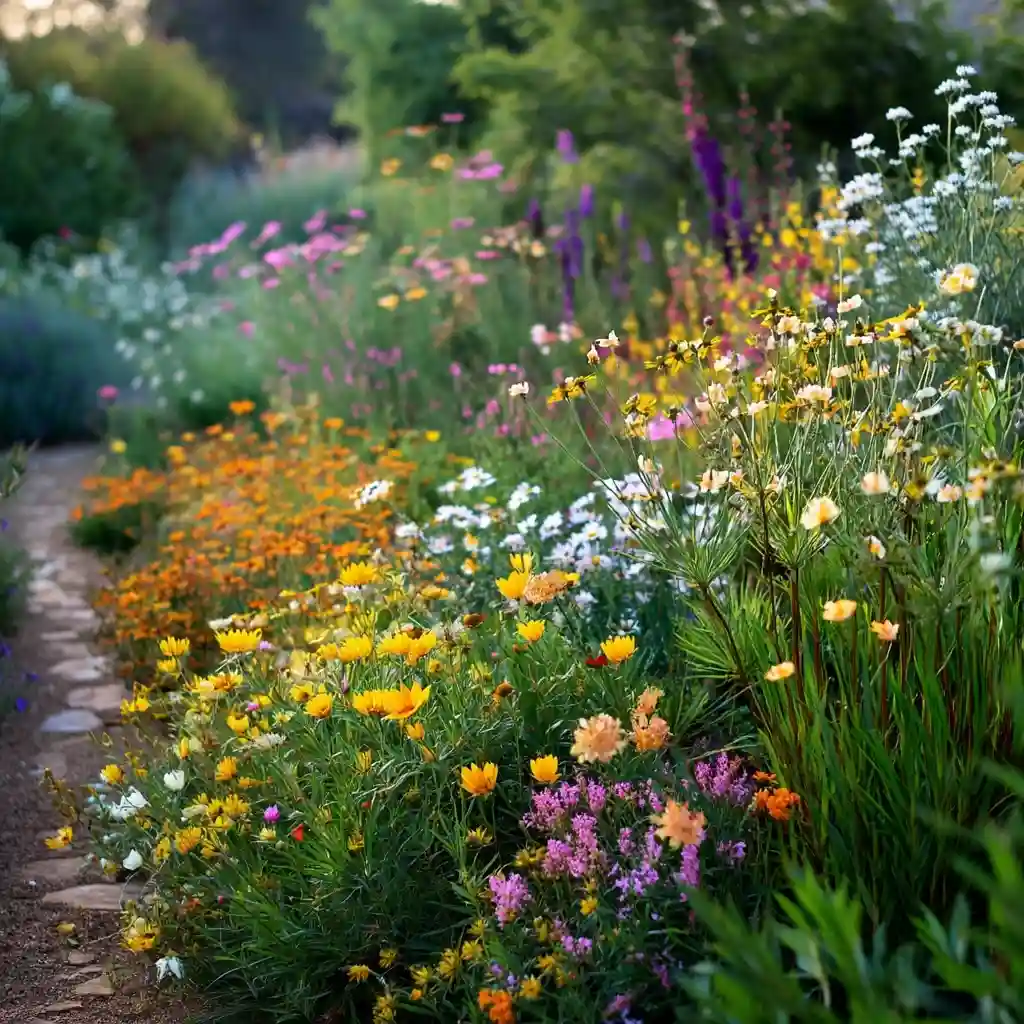
Planting native species is one of the most sustainable flower bed ideas for any garden. Native flowers are naturally adapted to your local climate and soil conditions, which means they typically require less water, fertilizer, and maintenance than non‑native species.
Beyond their resilience, native blooms like purple coneflowers, milkweed, and goldenrod attract beneficial insects, birds, and pollinators that help keep your garden healthy. These plants also contribute to biodiversity, supporting the local ecosystem while giving your landscape an authentic, natural look.
Before planting, research your USDA hardiness zone or regional growing guide to select the best native species for your area. By doing so, you’ll create a flower bed that practically takes care of itself while benefiting the environment.
3. Welcome Pollinators
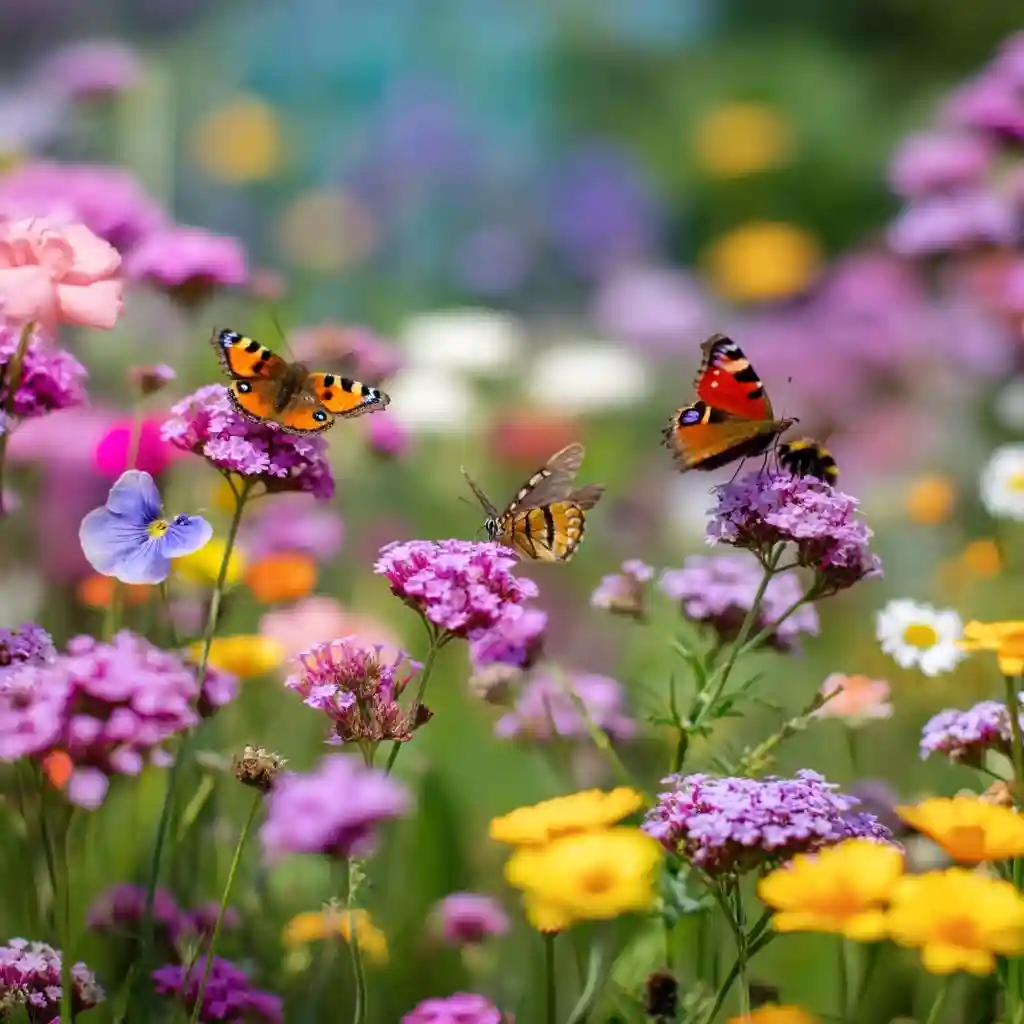
If you want a thriving garden, welcoming pollinators is one of the smartest flower bed ideas you can implement. Bees, butterflies, and hummingbirds play a crucial role in plant reproduction, and attracting them ensures healthier, more vibrant blooms.
Incorporate pollinator‑friendly plants like bee balm, butterfly bush, lavender, and asters. Planting in clusters rather than single scattered blooms makes it easier for pollinators to find your flowers. Avoid chemical pesticides whenever possible, as they can harm the very creatures your garden needs.
Adding a shallow water source, like a small dish with pebbles, can provide pollinators with a safe place to rest and drink. With the right combination of plants and care, your garden will hum with life while producing continuous waves of color.
4. Create an Herb Garden
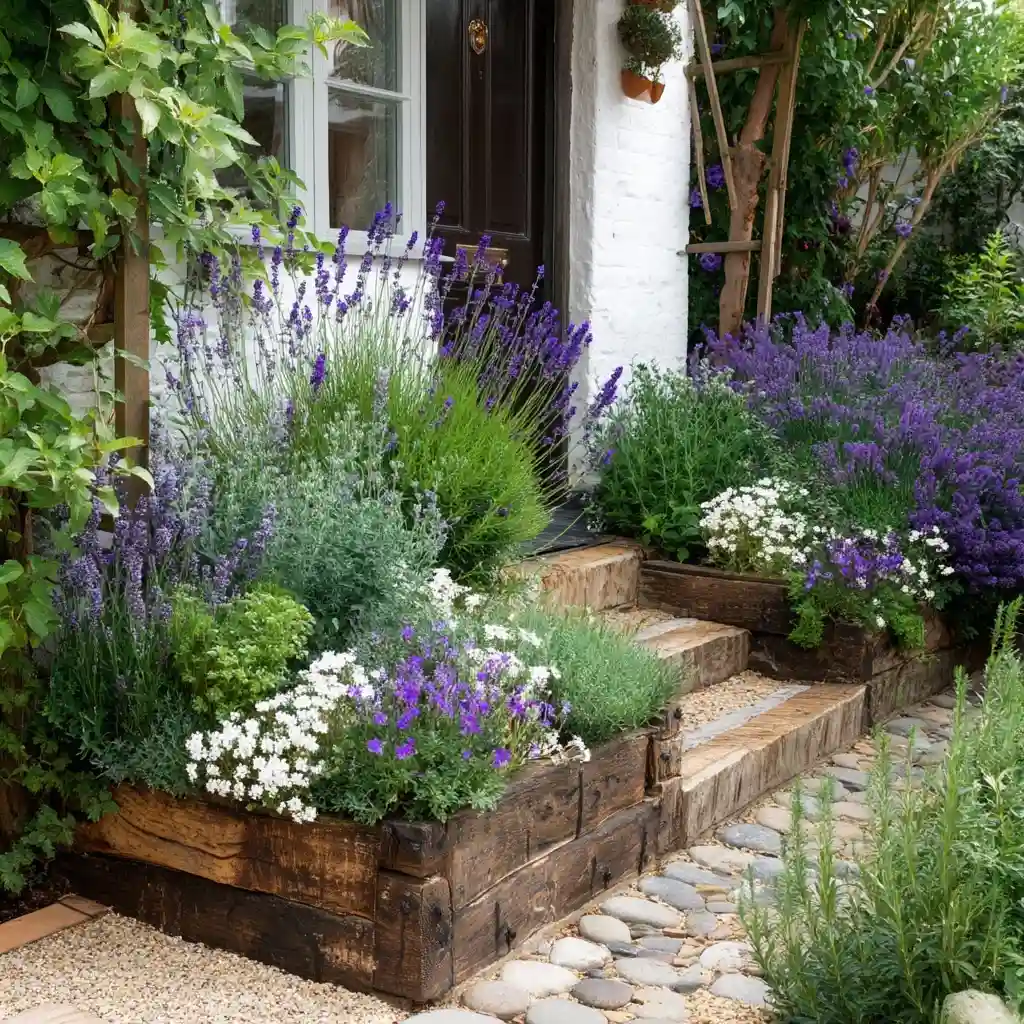
Turning part of your flower bed into an herb garden is both practical and beautiful, making it one of the most versatile flower bed ideas. Herbs like basil, thyme, rosemary, and oregano not only provide fresh flavors for your kitchen but also add interesting textures and fragrances to your garden.
Arrange herbs in clusters or borders, mixing them with colorful flowers for a dynamic look. For instance, pair purple basil with marigolds or plant lavender alongside roses for a fragrant, visually appealing bed. Many herbs also deter pests naturally, helping to protect your other plants without the need for harsh chemicals.
For easy access, plant your herb section near a walkway or kitchen entrance. This setup keeps your garden functional while giving you a steady supply of fresh, homegrown flavor.
5. Start a Border Garden

Creating a border garden is a classic flower bed idea that adds structure and charm to your landscape. Border gardens frame walkways, driveways, fences, or the edges of your lawn, creating a polished and cohesive look.
When designing a border garden, start with taller plants or shrubs at the back and gradually work down to shorter flowers at the front. This layering approach ensures that every bloom is visible while adding depth to your design. Popular border plants include daylilies, hostas, lavender, and salvia, which offer long‑lasting color and texture.
For a low‑maintenance option, consider mixing perennials with a few seasonal annuals. This approach gives you a reliable framework of plants that return each year, with pops of fresh color in the growing season.
6. Mix Edible Plants With Flowers
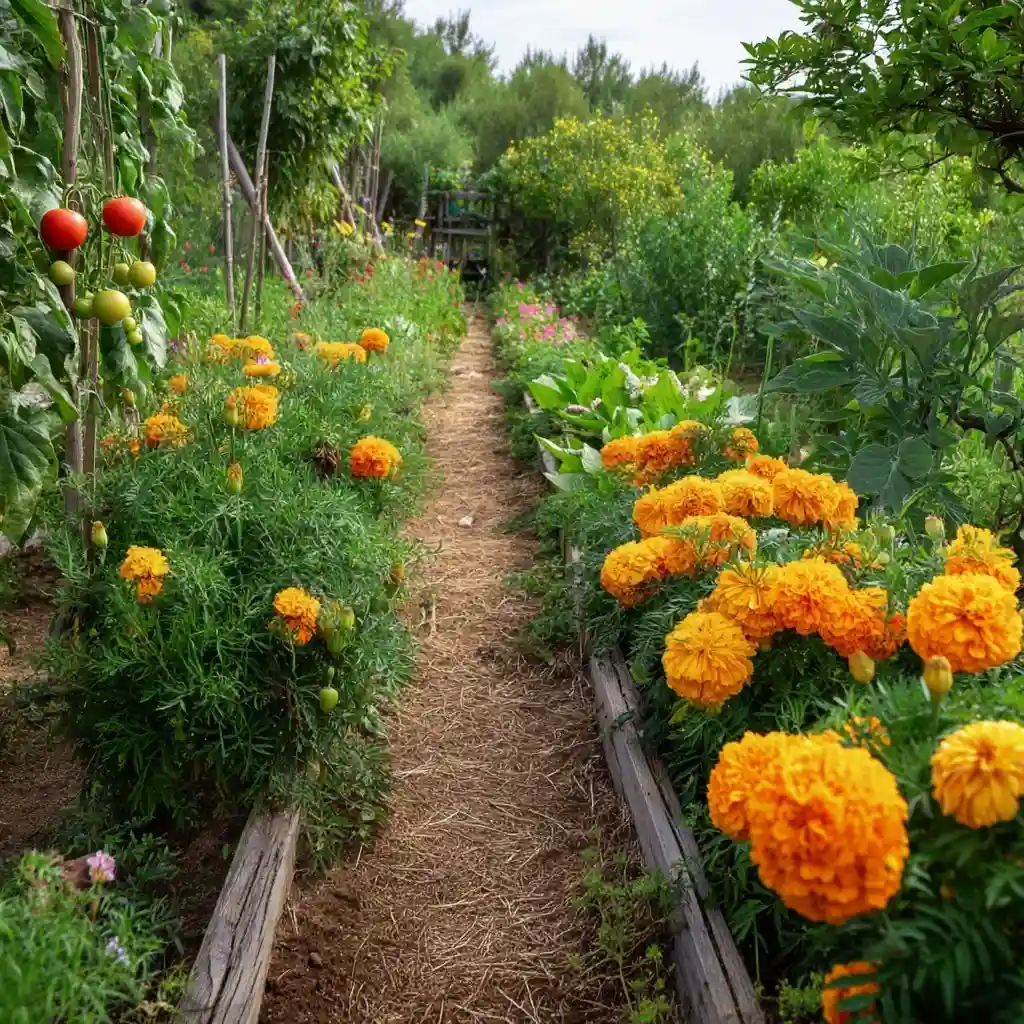
Combining vegetables and herbs with blooms is one of the most creative flower bed ideas for a productive and visually striking garden. Edible plants like kale, Swiss chard, peppers, and cherry tomatoes bring vibrant colors and unique leaf textures that pair beautifully with flowers.
This type of companion planting is more than just attractive—it can also be beneficial for your garden’s health. For example, marigolds deter certain pests, while basil enhances the flavor of nearby tomatoes. Mixing edibles with flowers allows you to make the most of your space while enjoying fresh harvests throughout the season.
For a balanced design, interplant edibles with flowers of similar sunlight and watering needs. This approach ensures that your garden remains easy to maintain while doubling as both a decorative and functional space.
7. Design a Cottage-Inspired Flower Bed
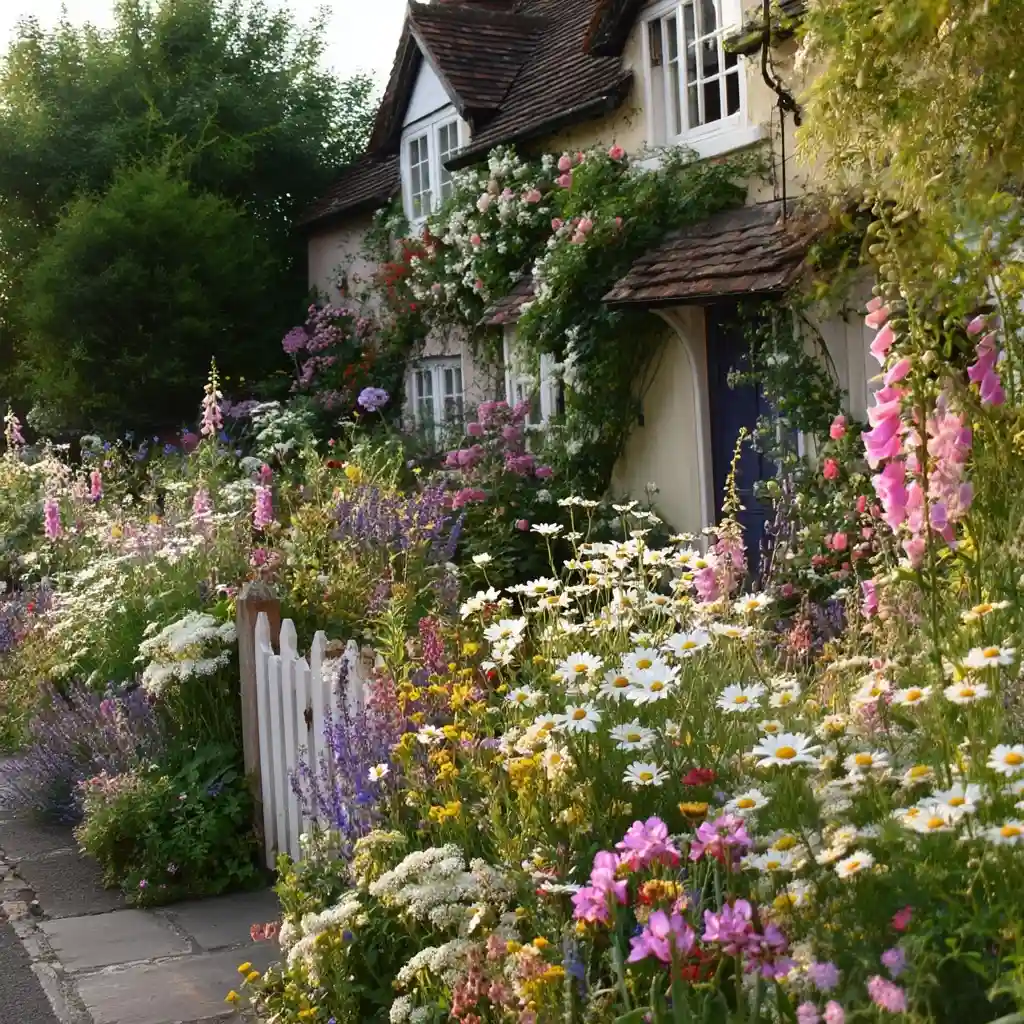
A cottage-style layout is one of the most charming flower bed ideas, perfect for gardeners who love a lush, slightly whimsical look. Cottage gardens are known for their abundance of color, layered plantings, and informal arrangements that make the space feel inviting and full of life.
Incorporate a mix of perennials and annuals like hollyhocks, foxgloves, delphiniums, and daisies. Adding climbers such as clematis or roses on a trellis or fence enhances the romantic feel of the design. Avoid planting in strict rows—overlapping layers and natural drifts create the effortless, storybook style that defines cottage gardens.
For an extra touch, include decorative elements like rustic fencing, vintage planters, or a small garden bench. These details complete the cozy, timeless aesthetic.
8. Create a Bed for Cut Flowers
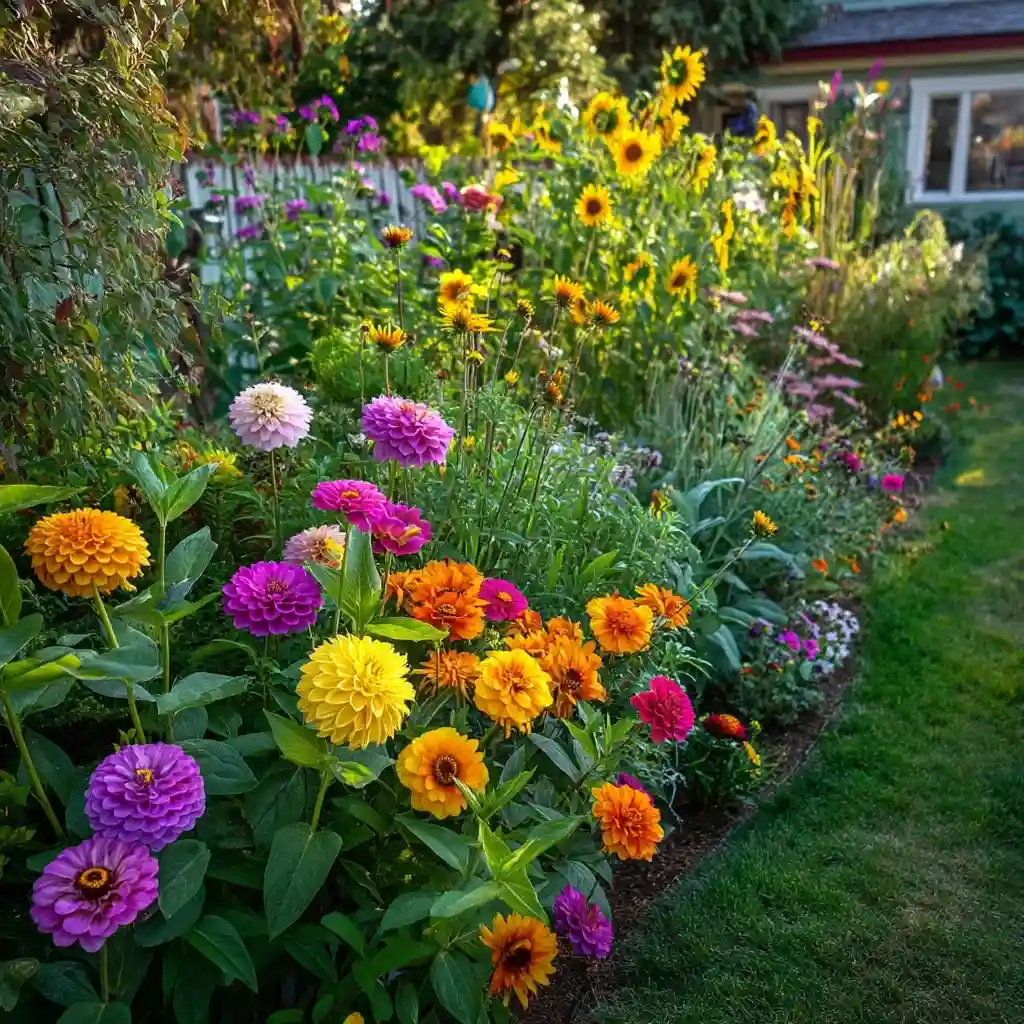
If you love bringing the beauty of your garden indoors, dedicating a section to cut flowers is a practical flower bed idea. A cut-flower bed ensures a continuous supply of fresh blooms for vases, arrangements, or gifts throughout the growing season.
Choose long-stemmed flowers that thrive when harvested, such as zinnias, dahlias, sunflowers, and snapdragons. Plant them in rows or clusters to make cutting easier and to encourage steady growth. Staggering bloom times by combining early, mid, and late-season flowers ensures that your garden produces color all season long.
Remember to feed and deadhead your cut flowers regularly. Healthy, well-tended plants will yield more blooms, letting you enjoy your garden’s beauty both outdoors and indoors.
9. Plant Fragrant Blooms
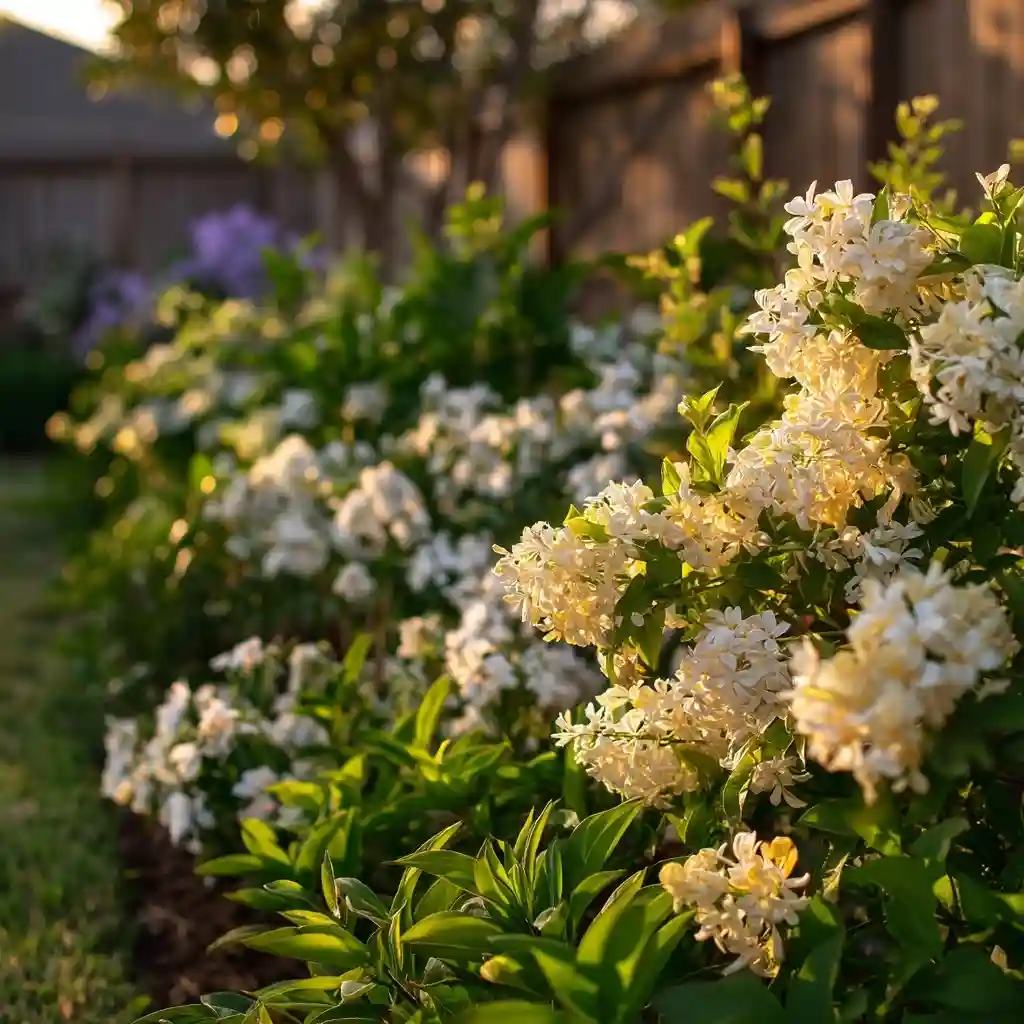
Adding fragrance to your garden is one of the most sensory‑pleasing flower bed ideas. A mix of aromatic flowers can turn your outdoor space into a relaxing retreat, especially in the evenings when scents become more noticeable.
Consider classic fragrant choices like roses, peonies, sweet peas, and lilacs. For continuous fragrance, mix in lavender, gardenias, or night-blooming jasmine, which release their perfume after sunset. Placing these blooms near seating areas, pathways, or windows allows you to enjoy their aroma up close.
To keep scents from competing, group flowers with complementary fragrances together. A well-planned fragrant flower bed not only looks beautiful but also makes your garden a delight to experience.
10. Grow Mediterranean Plants
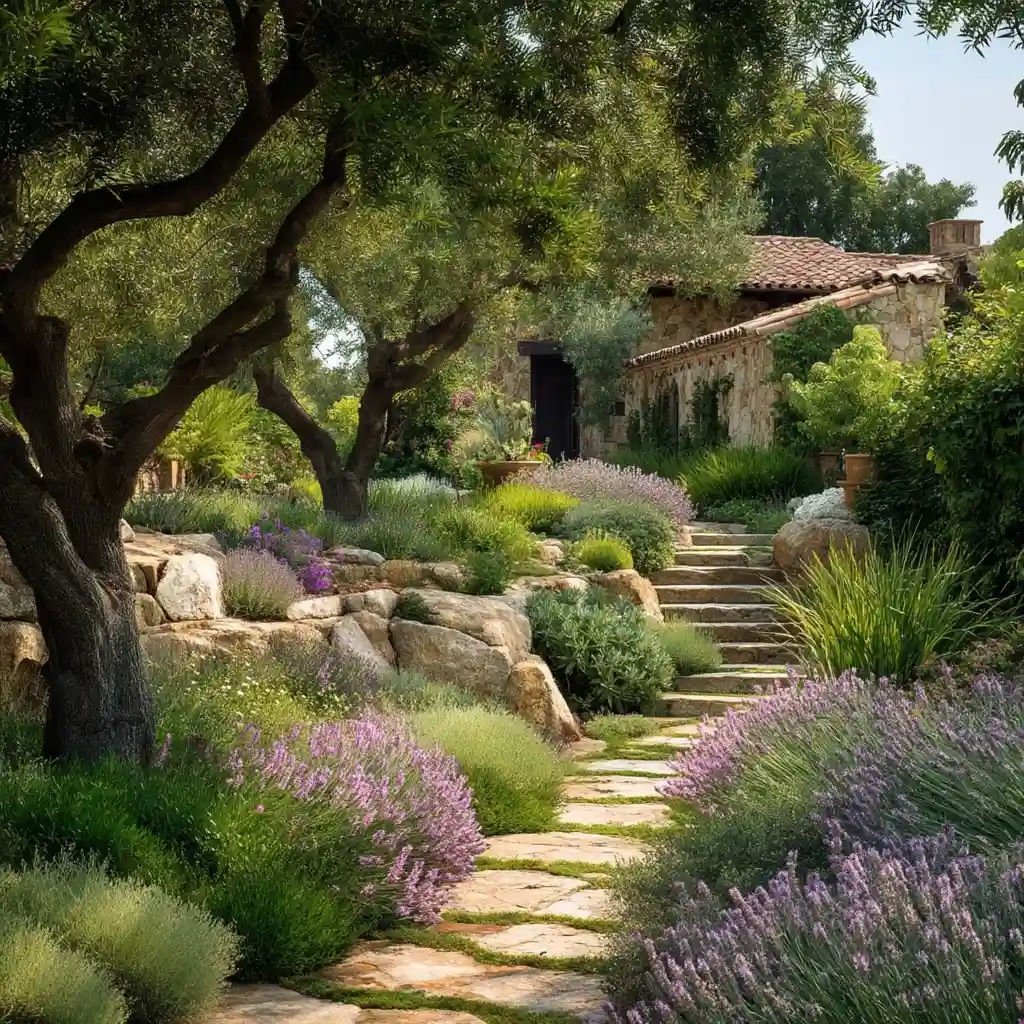
Incorporating Mediterranean species is a stylish and practical flower bed idea, especially for sunny, dry areas. These plants are naturally drought-tolerant, thrive in full sun, and bring a touch of coastal charm to your garden.
Popular Mediterranean choices include lavender, rosemary, sage, and rockrose. Their silvery-green foliage pairs beautifully with vibrant blooms like lantana or geraniums. Many of these plants also offer fragrant leaves and flowers, adding another sensory element to your garden.
For the best results, plant them in well-draining soil, preferably in raised or slightly sloped beds. Grouping these sun-loving plants together not only simplifies watering but also creates a cohesive, low-maintenance landscape with year-round appeal.
11. Plant for a Year of Flowers
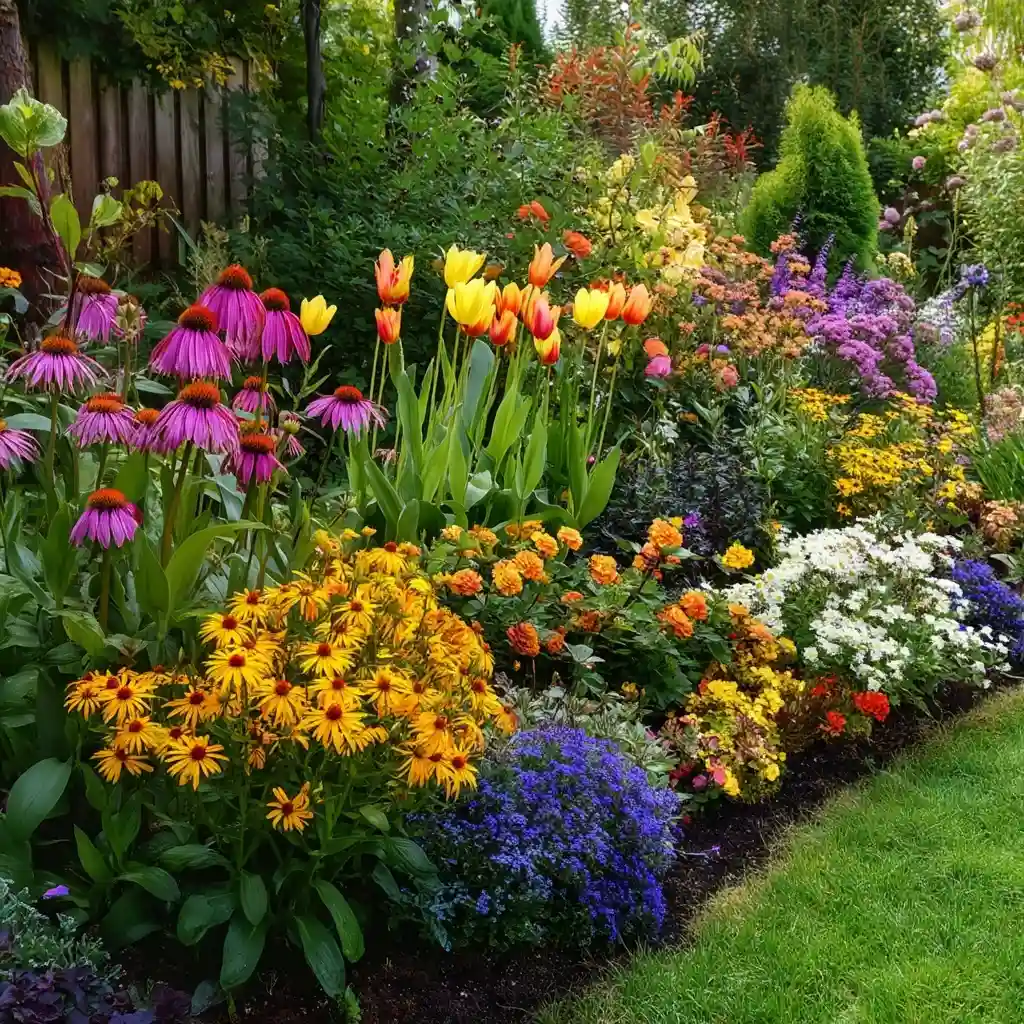
Planning for year-round blooms is one of the most rewarding flower bed ideas, ensuring your garden never looks bare. By combining early, mid, and late-season flowers, you can create a dynamic display that evolves with each season.
Start with spring bulbs like tulips, daffodils, and hyacinths for early color. Transition into summer with vibrant perennials such as daylilies, coneflowers, and black-eyed Susans. Finish the year with late bloomers like asters, mums, and ornamental grasses that add movement and texture.
When arranged thoughtfully, this succession planting approach provides continuous visual interest. Your garden will always have something in bloom, keeping it lively and inviting no matter the season.
12. Create a Drought-Tolerant Bed
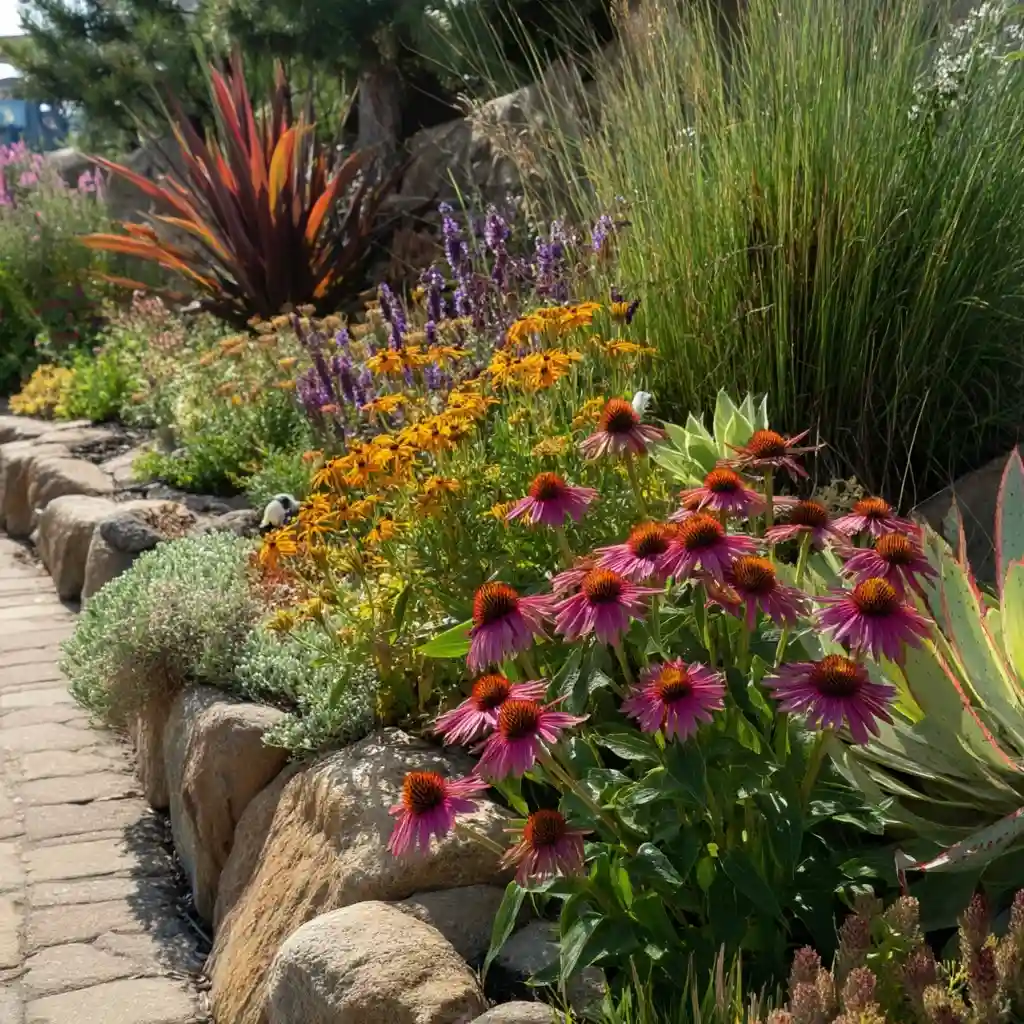
Designing a drought-tolerant garden is a smart flower bed idea for areas with hot summers or limited rainfall. These beds require minimal watering once established, making them eco‑friendly and low‑maintenance while still offering stunning visual appeal.
Select plants that thrive in dry conditions, such as blanket flowers, yarrow, echinacea, and sedum. Succulents and ornamental grasses can also add unique textures and shapes to your design. To retain moisture, use mulch or gravel around the base of your plants and group species with similar watering needs together.
Not only does this approach conserve water, but it also creates a resilient garden that looks beautiful even in challenging conditions.
13. Plant a Living Mulch
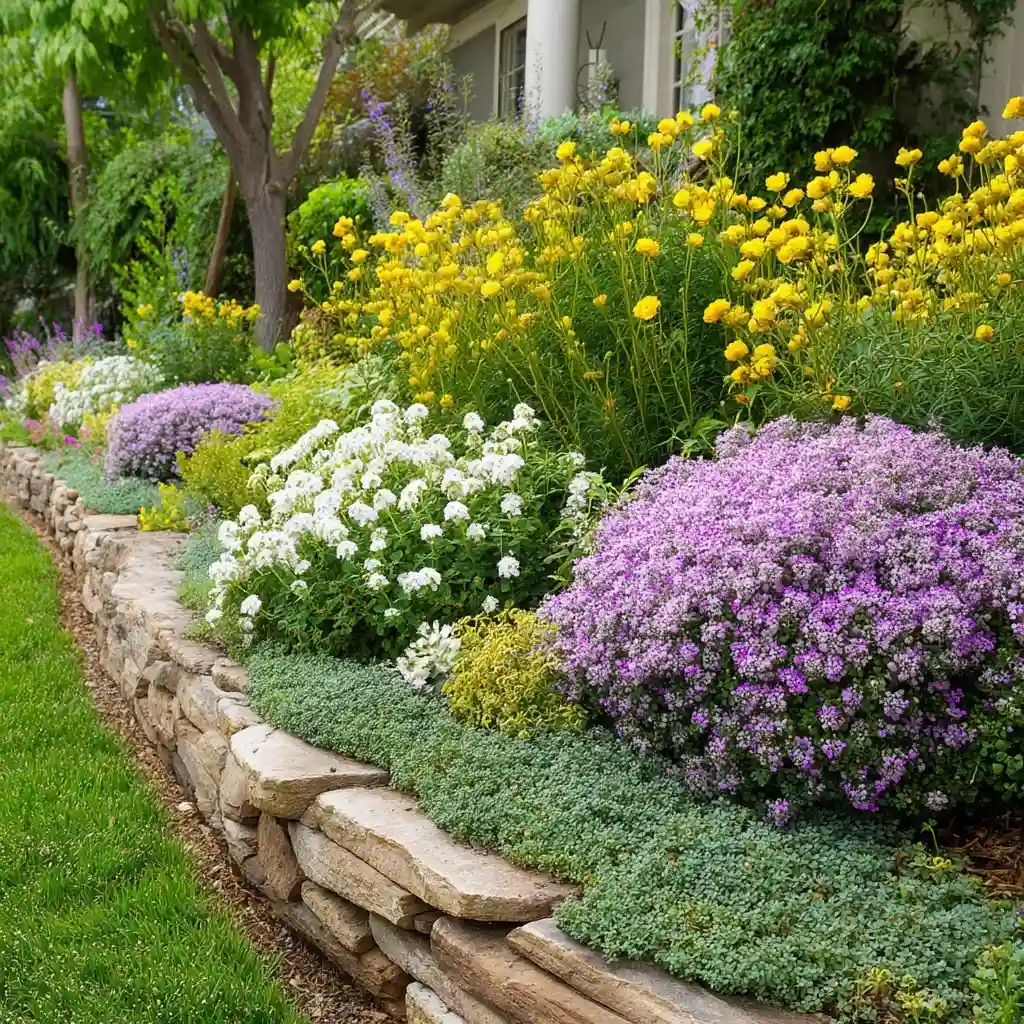
Using living mulch is an innovative flower bed idea that enhances soil health while reducing maintenance. Living mulch involves planting low-growing, ground-cover plants that act as a natural barrier against weeds, conserve moisture, and protect the soil from erosion.
Great options for living mulch include creeping thyme, sweet alyssum, vinca minor, and clover. These plants spread gently across the soil, filling in gaps between taller flowers and creating a lush, cohesive look.
Beyond practical benefits, living mulch adds another layer of color and texture to your flower bed. This approach not only saves time on weeding and watering but also contributes to a healthier, more sustainable garden.
14. Use Bunching Grasses
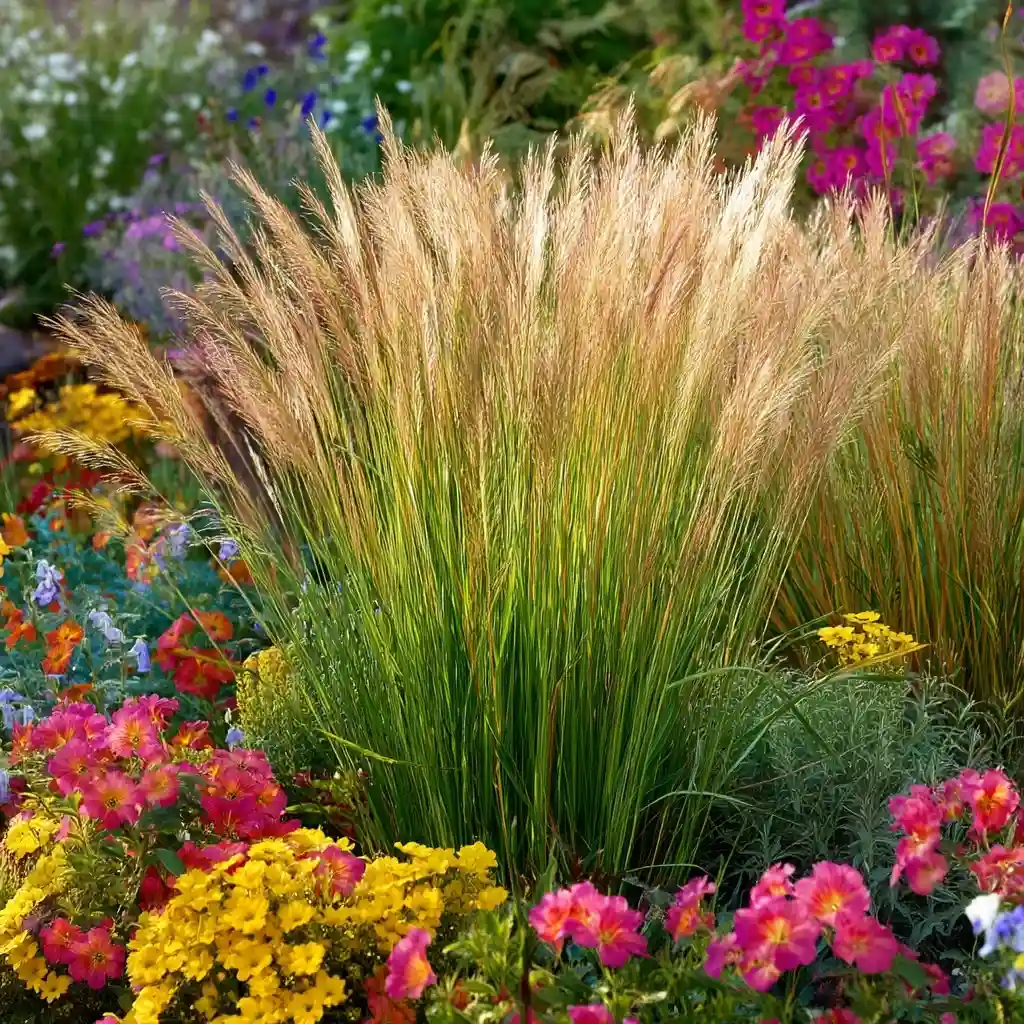
Adding ornamental grasses is a versatile flower bed idea that brings movement, texture, and seasonal interest to your garden. Bunching grasses create natural focal points, soften hard edges, and complement colorful blooms without overpowering them.
Choose varieties like fountain grass, blue fescue, or maiden grass for their graceful shapes and low-maintenance nature. Plant them in clusters throughout your flower bed to create rhythm and flow. Their plumes sway in the breeze, adding a dynamic element that flowers alone can’t provide.
As an added bonus, many ornamental grasses are drought-tolerant and return year after year, making them a sustainable choice for both decorative and functional garden designs.
15. Plant Aromatics for Pest Control
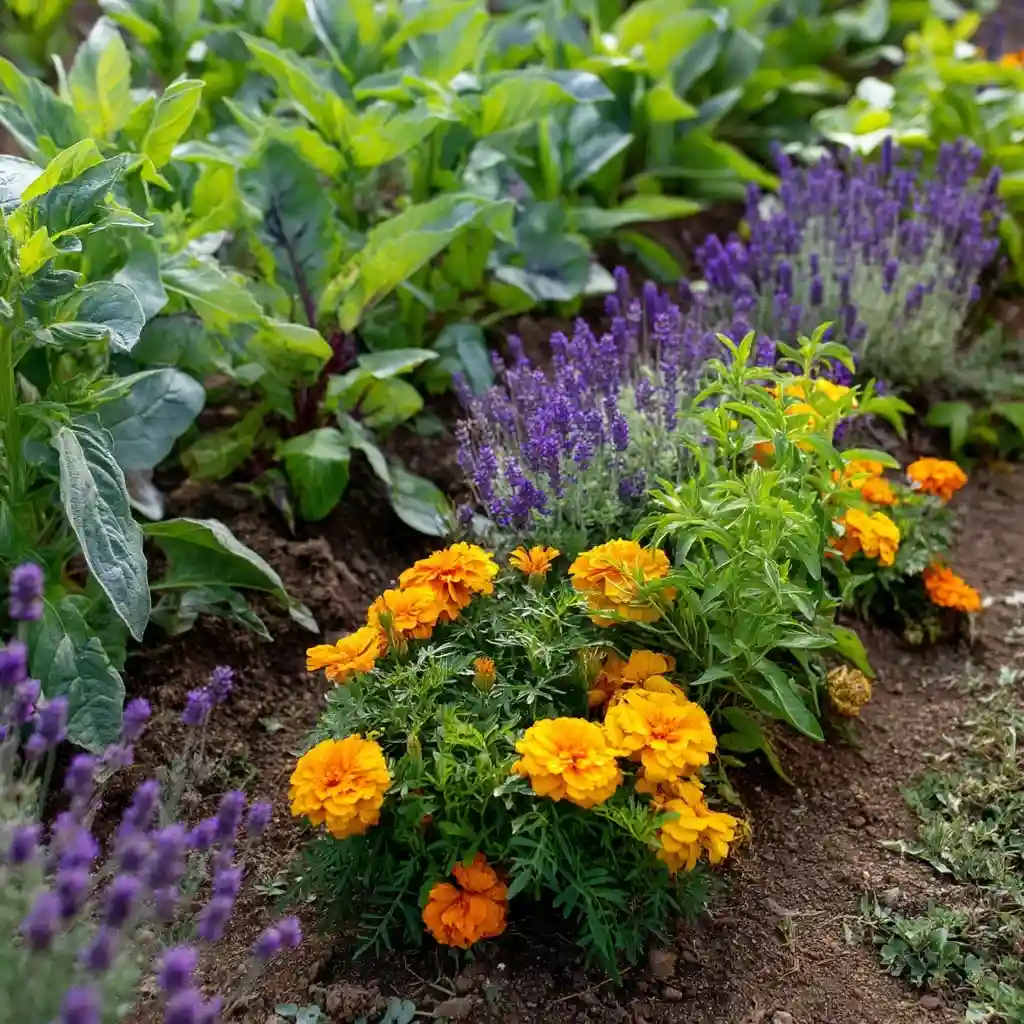
Incorporating aromatic plants into your flower bed is a practical flower bed idea that enhances beauty while helping to protect your garden naturally. Many fragrant herbs and flowers release essential oils that deter common pests like aphids, mosquitoes, and beetles.
Lavender, rosemary, thyme, and mint are excellent choices for both fragrance and function. Marigolds and chrysanthemums are also known for their pest‑repelling properties. Plant these aromatic species around the edges of your flower bed or between delicate blooms to create a natural protective barrier.
This approach not only reduces the need for chemical treatments but also keeps your garden buzzing with beneficial insects, creating a healthier, more balanced outdoor space.
16. Add Containers to Flower Beds
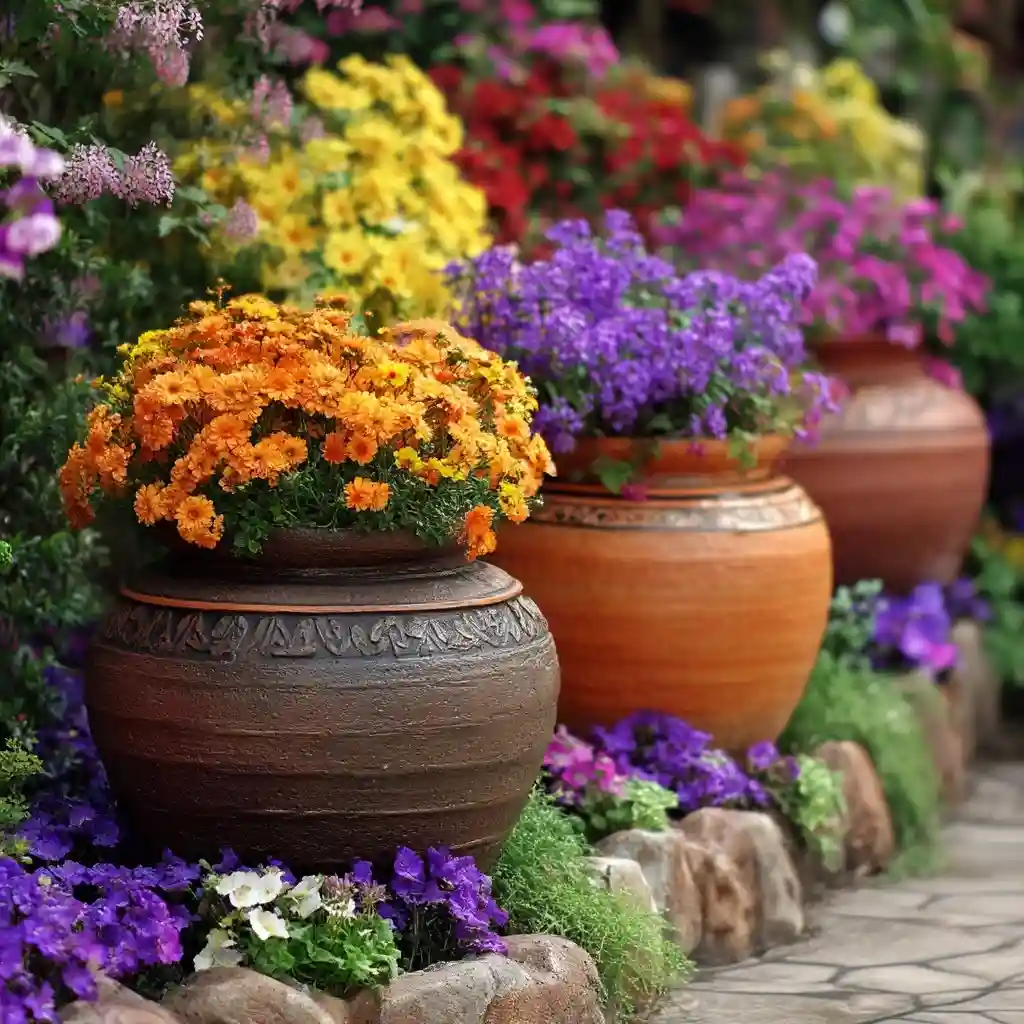
Incorporating containers into your garden layout is a flexible flower bed idea that adds height, color, and variety without a permanent commitment. Containers can hold seasonal blooms, trailing plants, or even small shrubs, giving you the freedom to refresh your garden’s look throughout the year.
Choose pots in different shapes, sizes, and materials to create visual interest. Terracotta, ceramic, or even repurposed wooden boxes can add personality to your space. Placing containers within your flower bed also allows you to showcase plants that need special soil or watering conditions without disturbing the rest of the garden.
To keep the design cohesive, coordinate container colors with your flower palette. This method lets you enjoy a dynamic garden that can evolve with each season.
17. Create Texture With Stones
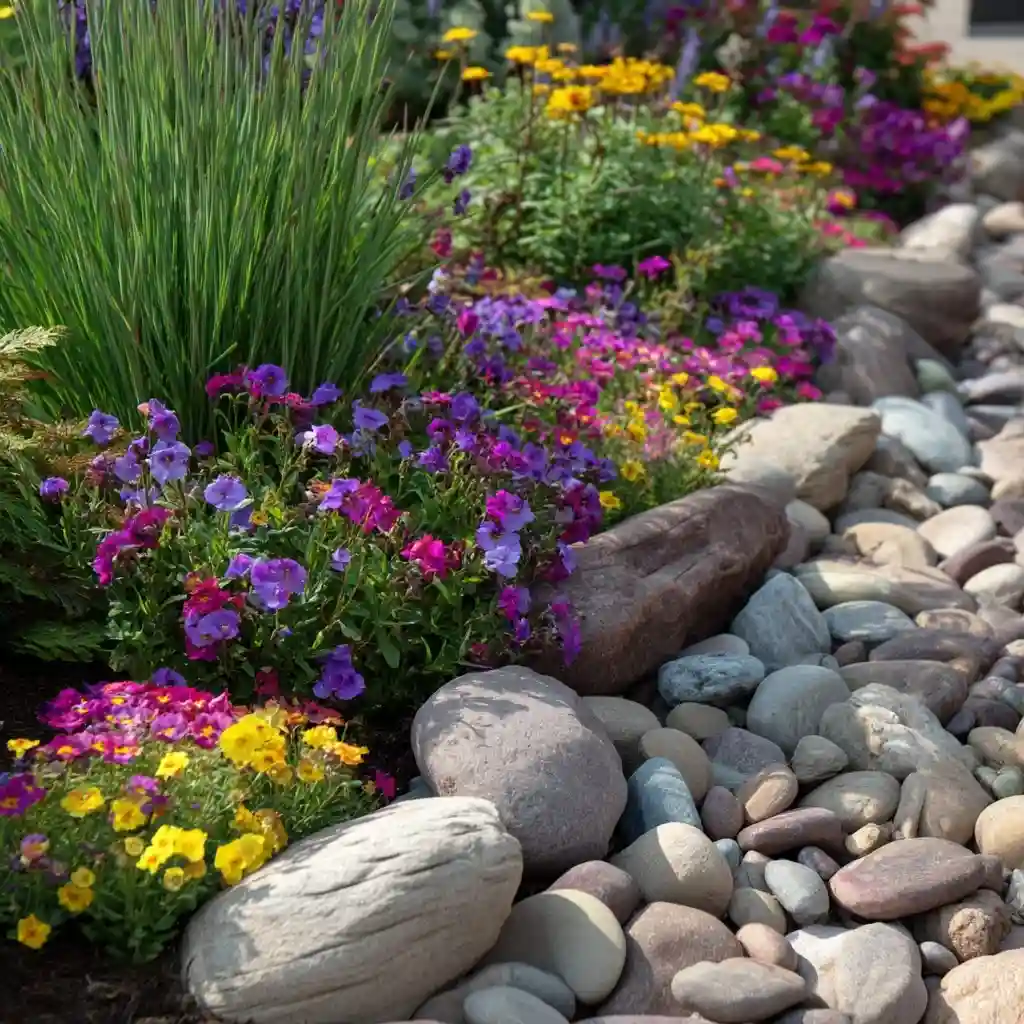
Incorporating stones into your landscape is a timeless flower bed idea that adds texture, structure, and a natural feel to your garden. Stones can define pathways, edge flower beds, or serve as focal points among blooming plants.
Use a mix of small pebbles, river rocks, or larger boulders to create visual contrast with soft petals and greenery. Stones also help with drainage, reduce soil erosion, and retain warmth, which can benefit certain sun-loving plants.
For an artistic touch, consider arranging stones in curved patterns or layering them to form gentle terraces. This combination of hard and soft elements enhances your flower bed’s visual appeal while offering practical landscaping benefits.
18. Plant for Color
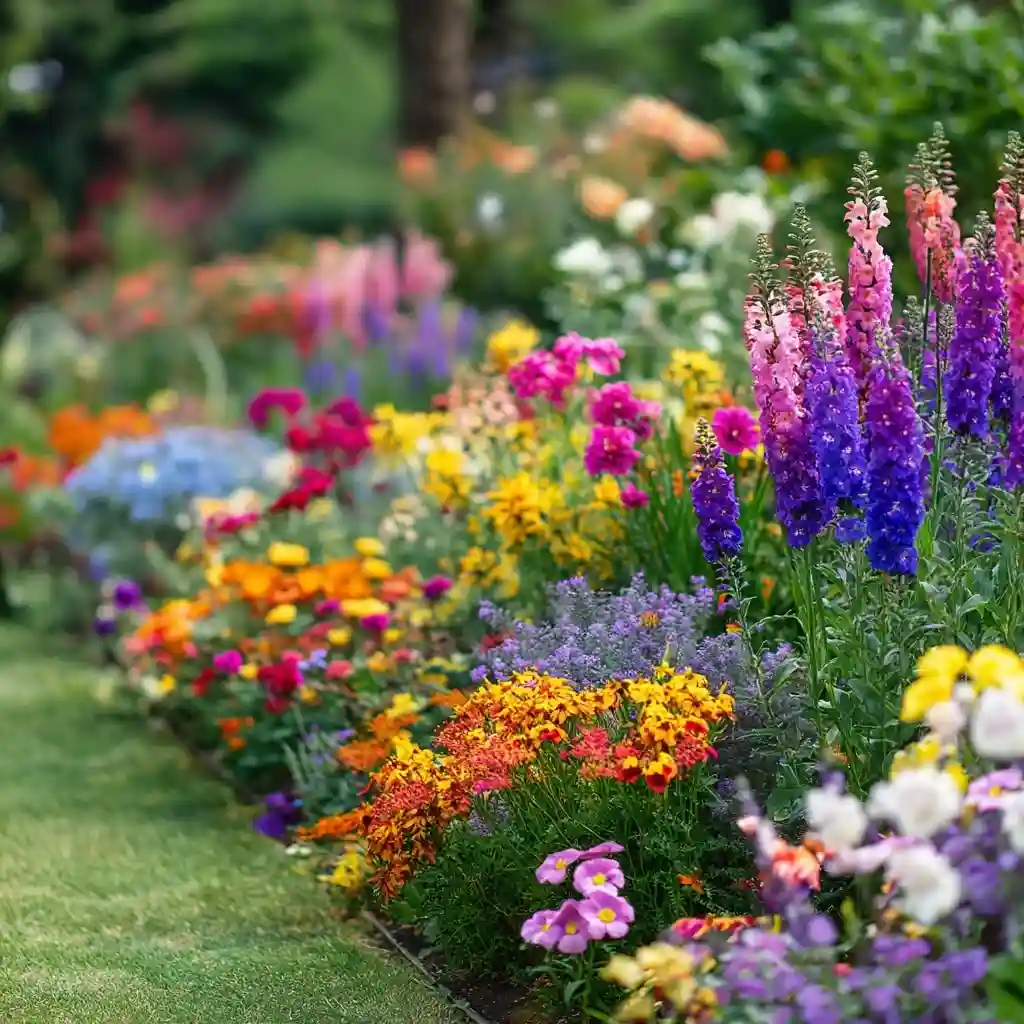
Designing your garden with a focus on color is one of the most visually striking flower bed ideas. A well-planned color scheme can transform your outdoor space into a vibrant display that changes with the seasons.
Start by selecting a color palette that reflects the mood you want—warm tones like red, orange, and yellow create energy, while cool shades like purple, blue, and white evoke calmness. Planting in clusters or swaths of the same color will make the hues pop and appear more intentional.
For continuous visual interest, mix annuals and perennials that bloom at different times. By thinking like a painter with your plants, your flower bed can become a living work of art.
19. Create Height With a Pergola
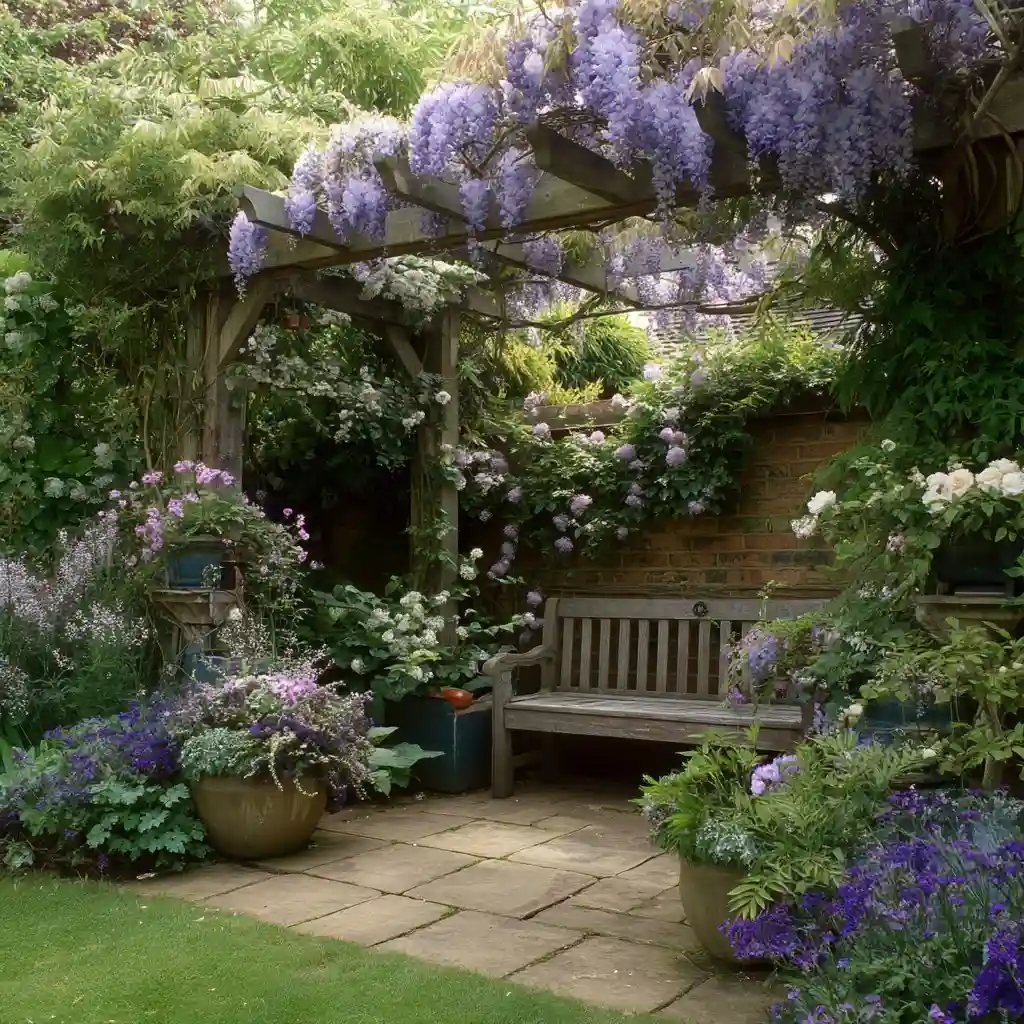
Adding vertical interest is a creative flower bed idea, and a pergola can transform a flat garden into a layered, dynamic space. Pergolas not only provide structure but also give climbing plants a place to thrive, creating a living canopy of color and greenery.
Choose vines like clematis, wisteria, or climbing roses to cover the pergola. Their cascading blooms and foliage add drama while providing shade and a cozy garden nook. Position your pergola near seating areas or pathways to make the most of its visual and functional impact.
To enhance the design, consider hanging planters or string lights from the structure. This approach adds height, depth, and charm, making your flower bed feel like an inviting garden retreat.
20. Make Gravel Garden Beds
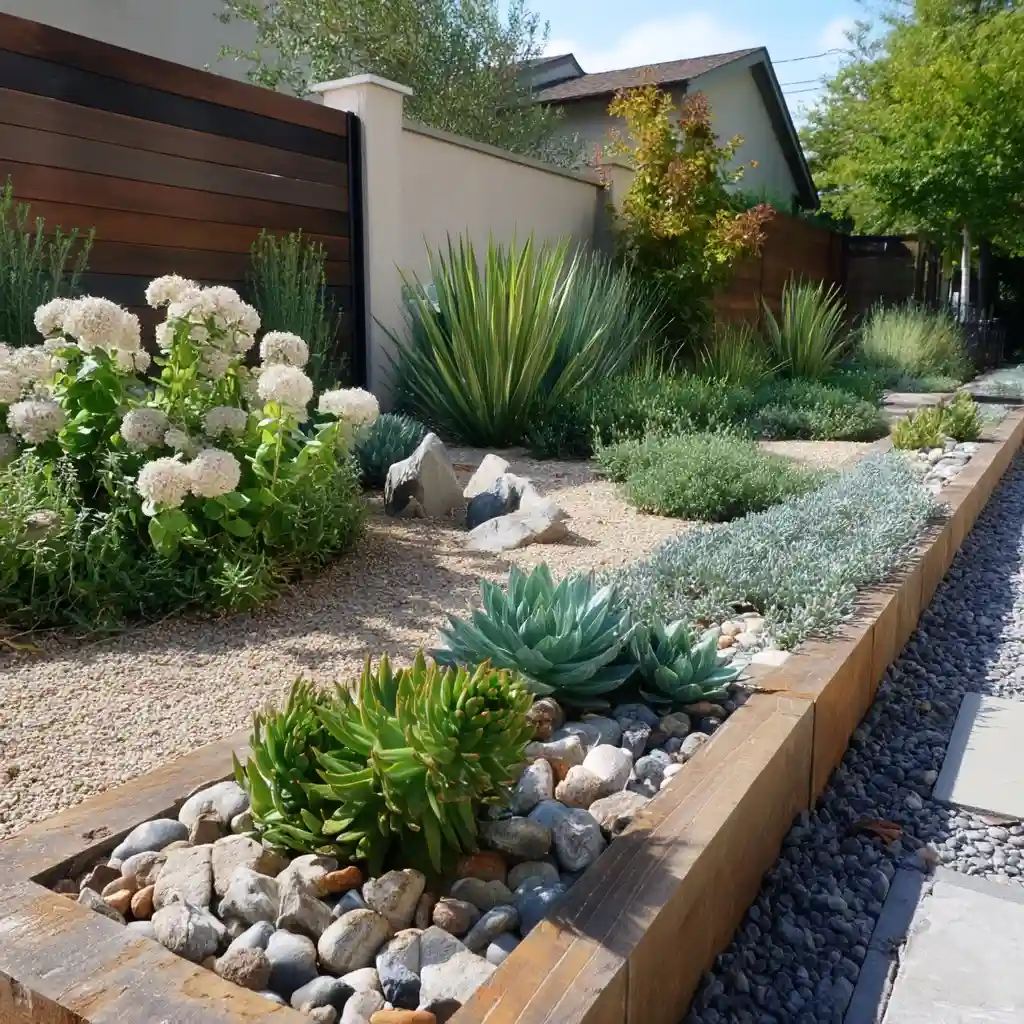
Using gravel in your garden beds is a practical flower bed idea that combines beauty with low maintenance. Gravel improves drainage, suppresses weeds, and creates a clean, modern look that highlights the colors and textures of your plants.
Start by lining the bed with landscape fabric to prevent weeds from growing through. Then, add a layer of gravel around drought-tolerant plants like lavender, sedum, or ornamental grasses. The contrast between soft blooms and rugged stone adds visual interest while keeping your garden neat.
Gravel beds are especially effective in hot, dry climates, as they help retain warmth and reduce evaporation. This approach creates a tidy, long-lasting flower bed that requires minimal upkeep.
21. Grow Flowers in a Raised Bed
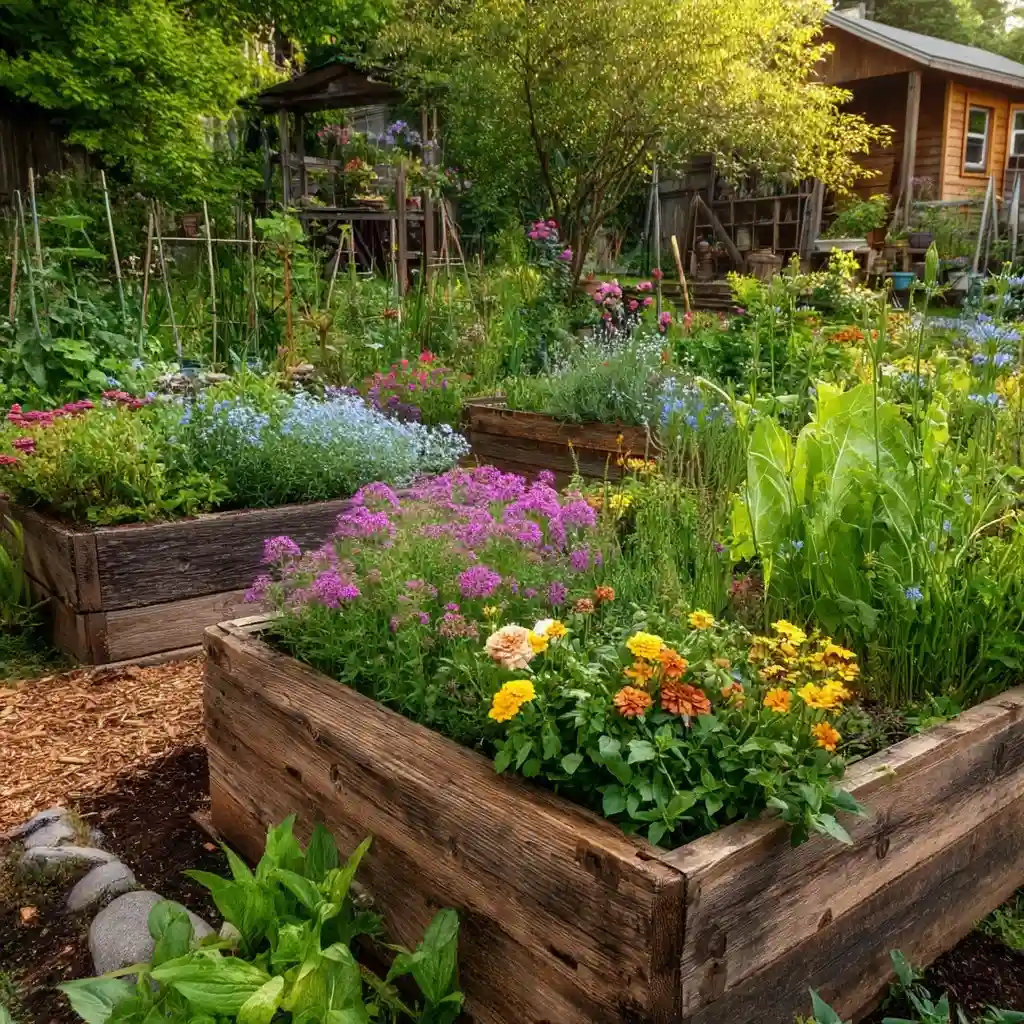
Planting in raised beds is a versatile flower bed idea that offers better control over soil quality, drainage, and plant organization. Raised beds elevate your flowers, making them easier to maintain while adding visual definition to your garden layout.
Fill raised beds with a mix of nutrient‑rich soil and compost to give blooms the best start. This setup works especially well for plants that struggle in heavy clay or sandy soils. You can also create layers of color by placing taller plants toward the center or back and cascading flowers along the edges.
Raised beds are perfect for small yards or urban gardens because they make the most of limited space. With proper care, they produce lush, healthy blooms with minimal effort.
22. Play With Height
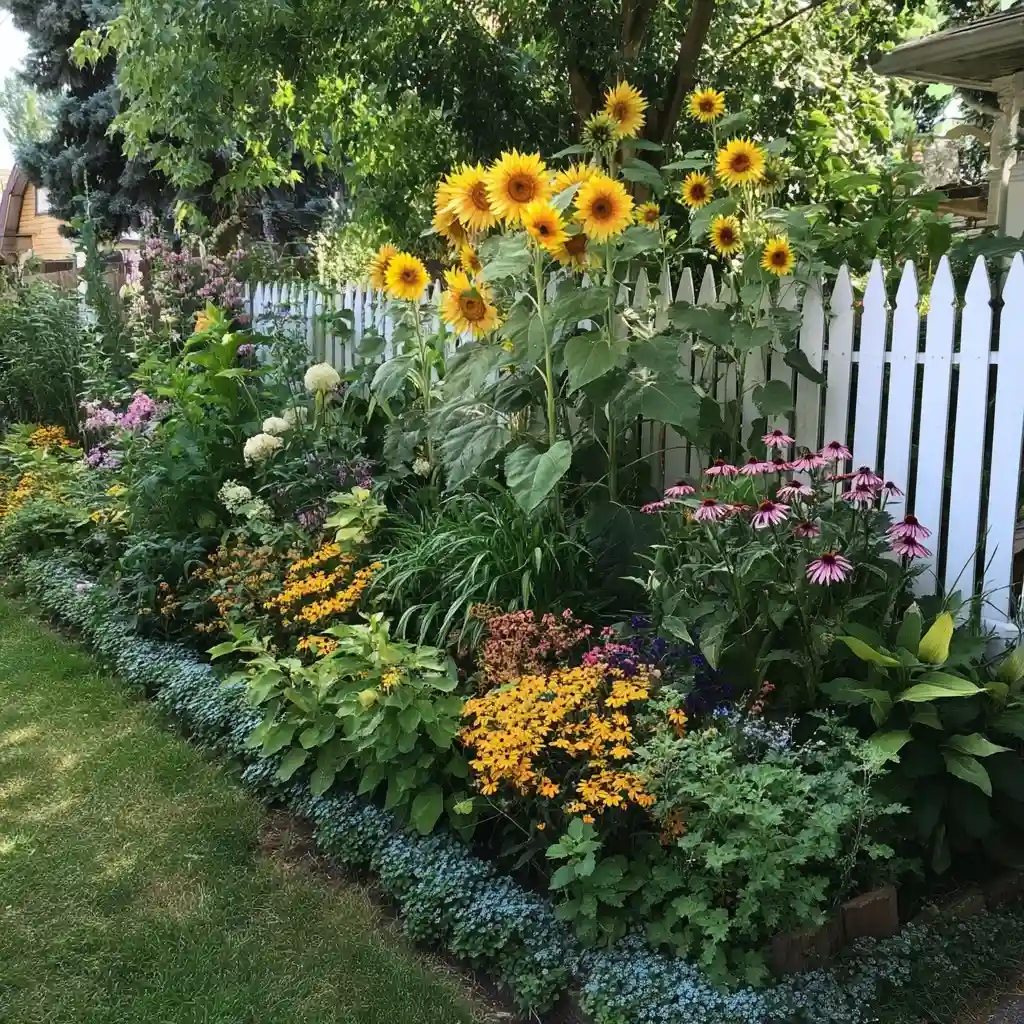
Varying the height of your plants is a dynamic flower bed idea that adds depth and visual interest to any garden. A flat bed can feel one-dimensional, but layering flowers from tall to short creates a natural flow that draws the eye across your space.
Start with taller plants like hollyhocks, delphiniums, or sunflowers in the back or center, depending on whether your bed is against a wall or visible from all sides. Mid-height flowers such as echinacea and black-eyed Susans can fill the middle layer, while low-growing plants like alyssum or pansies create a soft edge in the front.
This tiered arrangement not only enhances aesthetics but also ensures that every bloom is visible, resulting in a fuller, more polished garden design.
23. Grow Flowers That Engage the Senses
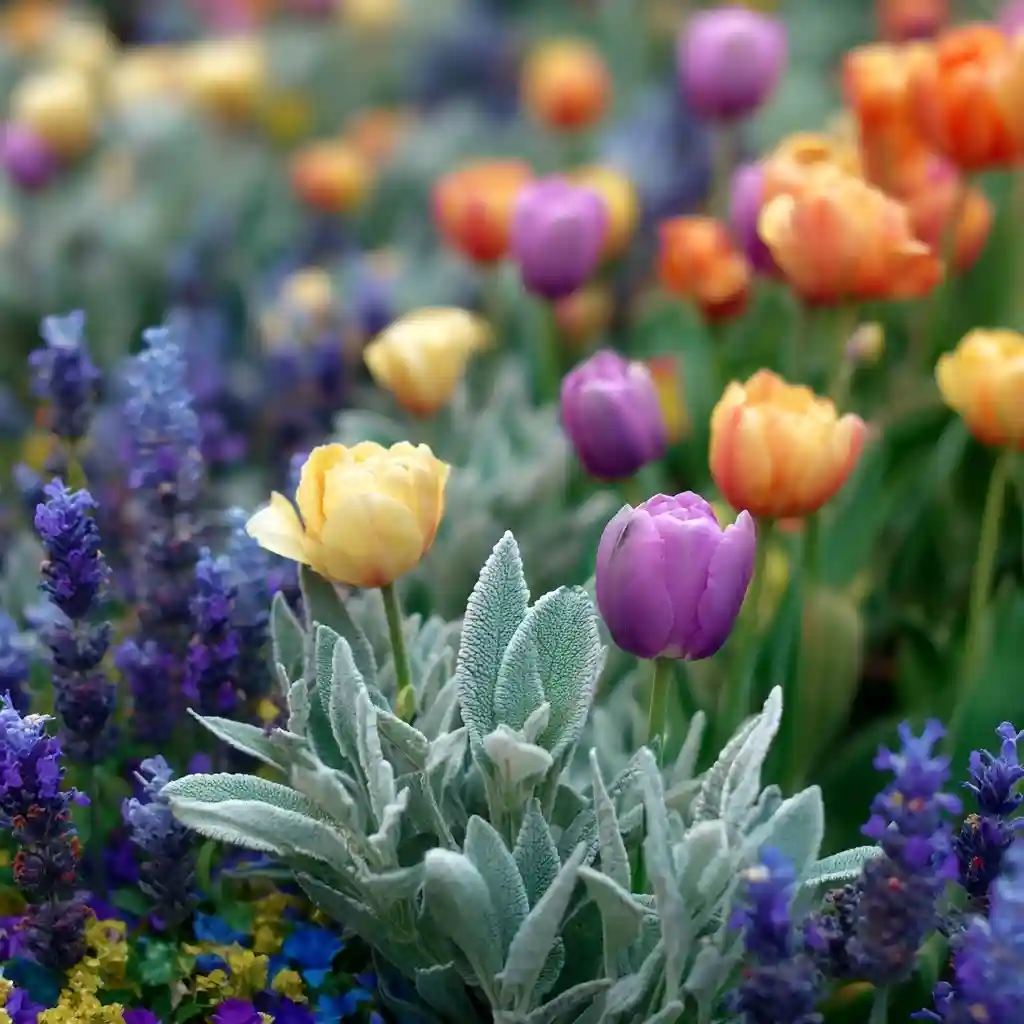
Designing a multi-sensory garden is a memorable flower bed idea that enhances your outdoor experience. By choosing flowers that appeal to sight, smell, and touch, you create a space that feels immersive and inviting.
Brightly colored blooms like zinnias, cosmos, and tulips provide instant visual impact. Fragrant choices such as lavender, jasmine, or gardenias fill the air with pleasant aromas, while soft, touchable plants like lamb’s ear or fountain grass add a tactile element.
For maximum effect, place sensory flowers along walkways, near seating areas, or around patios where you can enjoy them up close. This approach transforms a simple flower bed into a living, interactive retreat.
24. Add a Bird Bath
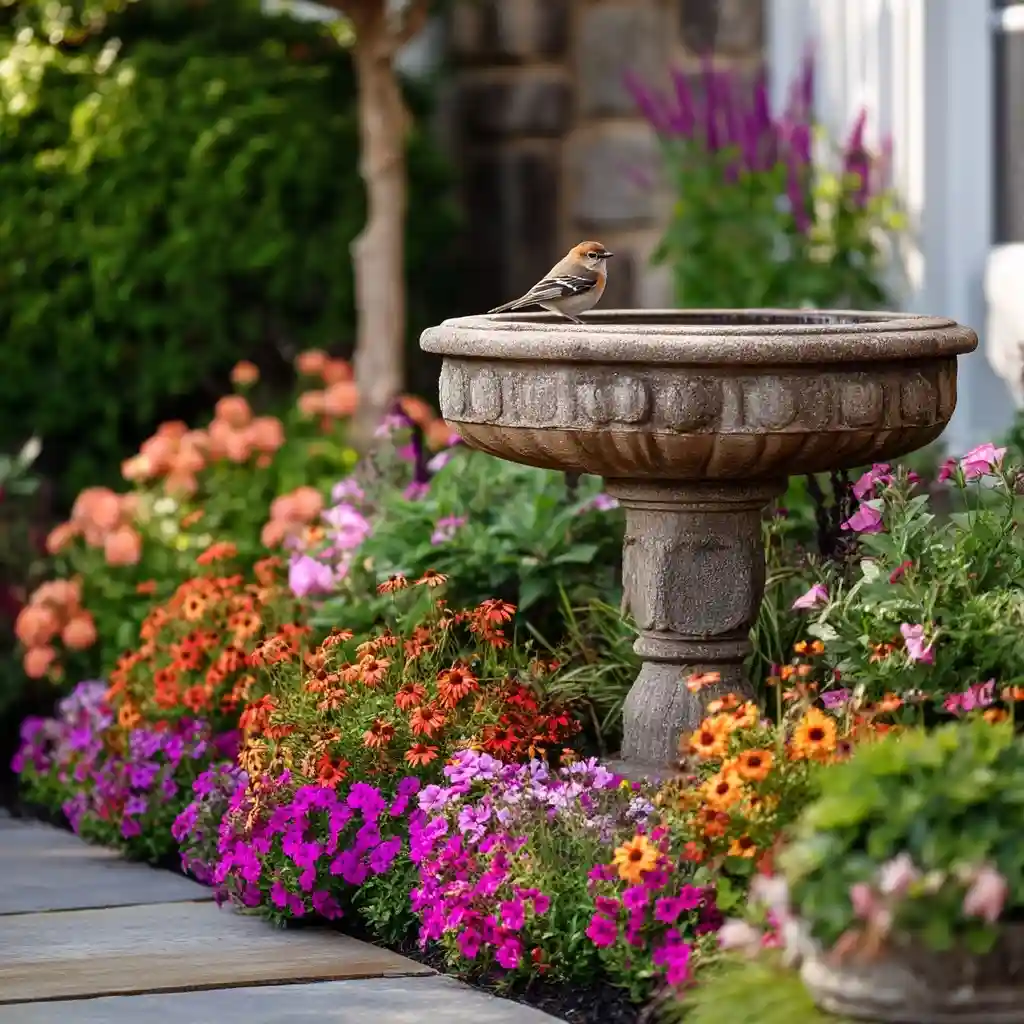
Including a bird bath in your garden is a charming flower bed idea that brings both beauty and life to your outdoor space. Bird baths attract songbirds, which not only provide natural entertainment but also help with pest control by feeding on insects.
Position your bird bath in a partially shaded spot within your flower bed to keep the water cool and inviting. Surround it with colorful blooms like coneflowers, zinnias, or sunflowers to create a lively focal point that blends nature with design.
To maintain a healthy habitat, refresh the water regularly and clean the bath to prevent algae buildup. This simple addition enhances your garden’s aesthetic while supporting local wildlife.
25. Create a Seating Arrangement
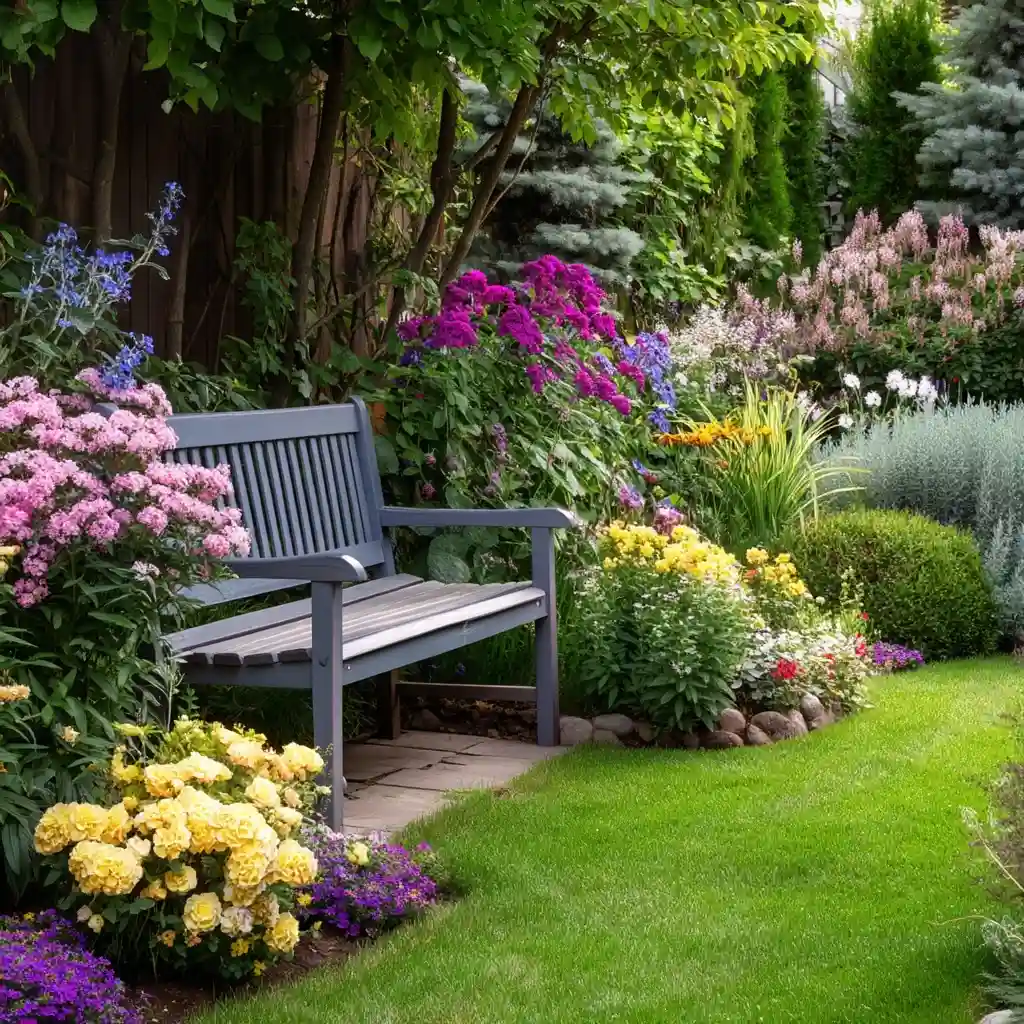
Adding a cozy seating spot is a functional flower bed idea that allows you to fully enjoy your garden. Nestling a bench, bistro set, or swing among the blooms turns your flower bed into a relaxing retreat where you can read, sip coffee, or simply admire your hard work.
Choose weather‑resistant furniture and place it in a spot that offers shade during the hottest part of the day. Surround the area with colorful, fragrant flowers like roses, lavender, or peonies to enhance the sensory experience.
A seating area also invites guests to linger and appreciate the garden’s beauty, transforming your flower bed into a living space rather than just a visual feature.
Conclusion
These flower bed ideas can transform any outdoor space into a vibrant and inviting garden. Whether you’re designing a cottage-inspired corner, incorporating drought-tolerant plants, or adding features like bird baths and seating areas, each approach brings beauty and personality to your yard. By mixing colors, textures, and heights, you can create a dynamic flower bed that evolves with the seasons and provides year-round enjoyment.
Remember, the best gardens are the ones that reflect your personal style while supporting healthy plants and local wildlife. Start with one idea, then expand as your garden grows—soon, your flower beds will be a stunning highlight of your landscape.
🌿 Love gardening inspiration? Follow me on Pinterest for bold plant ideas, tips, and seasonal color!
More Posts
